Key Takeaways
- Discover the most advanced Data Management Platforms (DMP) of 2026 that streamline data collection, integration, and activation for better marketing outcomes.
- Learn how AI-driven automation, privacy compliance, and first-party data strategies are reshaping the future of digital marketing.
- Understand which top DMPs offer superior scalability, real-time analytics, and seamless integration for data-driven business growth.
In the rapidly evolving digital era, data has become the driving force behind every successful business strategy. As organizations increasingly rely on analytics, personalization, and automation to reach their audiences, the demand for powerful and reliable Data Management Platforms (DMPs) continues to grow. By 2026, DMPs have transformed into essential tools for marketing teams, advertisers, and enterprises aiming to harness the full potential of customer data. These platforms enable businesses to collect, organize, and activate vast amounts of structured and unstructured data from multiple sources, ensuring precise audience segmentation, enhanced targeting, and improved return on investment (ROI).

The competitive landscape of DMPs in 2026 reflects a major technological shift, driven by artificial intelligence (AI), privacy regulations, and the integration of Customer Data Platforms (CDPs). Modern DMPs now go beyond basic data aggregation—they combine advanced analytics, machine learning, and real-time processing to deliver deeper insights and predictive intelligence. As companies adapt to a cookieless world, top DMPs are redefining how brands engage consumers through first-party and consent-based data strategies, ensuring compliance with global data protection laws such as GDPR and CCPA.
Choosing the right Data Management Platform can be a complex decision, as each platform offers unique capabilities tailored to specific business needs. Leading DMPs like Adobe Audience Manager, Salesforce Data Cloud, LiveRamp, Lotame, and Oracle BlueKai have evolved their systems to deliver unified customer profiles, personalized audience experiences, and seamless integration with marketing ecosystems. Meanwhile, emerging players such as Permutive, Tealium, and Twilio Segment are focusing on privacy-first, AI-driven, and composable architectures that empower organizations to build flexible, scalable, and secure data frameworks.
In 2026, DMPs are no longer just marketing tools—they have become strategic assets that enable businesses to achieve a 360-degree understanding of their customers. By integrating data across digital, mobile, and offline channels, these platforms allow marketers to gain real-time visibility into audience behavior, identify trends, and deliver targeted campaigns that drive measurable business outcomes. Moreover, the integration of data warehouse connectivity, cloud-native solutions, and automation capabilities ensures that businesses can manage data at scale while maintaining performance and efficiency.
This comprehensive guide explores the Top 10 Best Data Management Platforms (DMPs) for 2026, evaluating them based on functionality, scalability, integration capabilities, user experience, and overall market presence. Readers will gain insights into how each platform stands out in terms of data processing power, analytics accuracy, privacy features, and adaptability to future data trends. Whether you are a digital marketer, data analyst, or enterprise decision-maker, understanding these platforms can help you make informed choices that align with your organization’s data strategy.
As businesses move toward a more data-centric and privacy-aware future, DMPs continue to serve as the foundation for intelligent marketing, customer engagement, and data governance. The coming years will see these platforms evolve even further—powered by automation, AI, and interoperability—to help organizations make smarter, faster, and more ethical data-driven decisions. This blog provides a deep dive into the leading DMP solutions shaping 2026, offering valuable insights to help you select the best technology for your company’s digital transformation journey.
Before we venture further into this article, we would like to share who we are and what we do.
About 9cv9
9cv9 is a business tech startup based in Singapore and Asia, with a strong presence all over the world.
With over nine years of startup and business experience, and being highly involved in connecting with thousands of companies and startups, the 9cv9 team has listed some important learning points in this overview of the Top 10 Best Data Management Platforms (DMP) for 2026.
If your company needs recruitment and headhunting services to hire top-quality employees, you can use 9cv9 headhunting and recruitment services to hire top talents and candidates. Find out more here, or send over an email to [email protected].
Or just post 1 free job posting here at 9cv9 Hiring Portal in under 10 minutes.
Top 10 Best Data Management Platforms (DMP) for 2026
- Adform
- Oracle BlueKai
- Salesforce Data Cloud
- Adobe Real-Time CDP
- Twilio Segment
- LiveRamp
- Lotame
- The Trade Desk
- Permutive
- Tealium Customer Data Hub
1. Adform
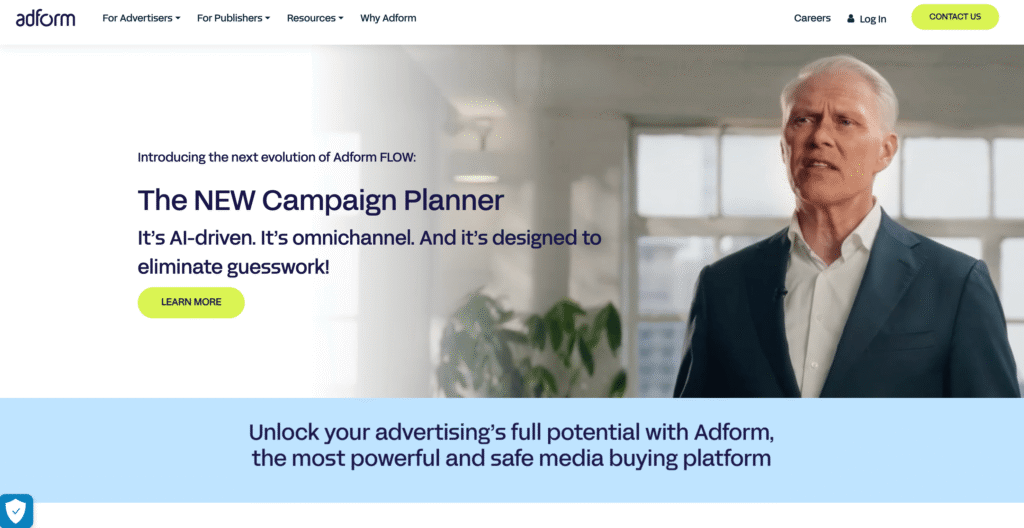
Adform stands as one of the top data management platforms (DMPs) for 2026, recognized globally for its advanced and integrated AdTech solutions. It combines a Demand-Side Platform (DSP), Supply-Side Platform (SSP), and Data Management Platform (DMP) under a single ecosystem, offering advertisers, marketers, and agencies a powerful toolset for efficient, data-driven campaign management.
Its global reputation is built upon strong performance metrics, innovative technology, and an unwavering focus on transparency. As of 2025, Adform maintains a notable 21.21% market share in the DMP sector, serving over 10,000 customers worldwide. Its continued growth and technological evolution make it a dominant player in the advertising technology landscape.
Overview and Core Capabilities
Adform’s DMP, known as Adform Audience Base, serves as a central hub for collecting, organizing, and activating audience data across digital channels. It is designed to provide advertisers with real-time visibility and control over their data, ensuring transparency at every stage of a campaign. Built on the Adform FLOW architecture, the platform is engineered for scalability, seamless integration, and an intuitive user experience.
Key strengths include:
- Centralized data collection and segmentation for improved targeting accuracy.
- Real-time decision-making capabilities that enhance ad performance.
- Seamless interoperability across Adform’s DSP and SSP for end-to-end campaign management.
- A strong emphasis on user privacy and compliance with international data regulations.
Key Features and Differentiators
AI-Powered Campaign Planner
- Introduced in early 2025, this tool leverages Adform IQ to automate and optimize omnichannel campaign planning.
- It provides real-time analytics, cross-channel insights, and predictive recommendations for enhanced efficiency.
Real-Time Bidding and Analytics
- Processes billions of ad transactions daily with millisecond response times.
- Enables precise audience segmentation and dynamic bidding optimization.
ID Fusion Technology
- Developed to overcome the challenges of a cookie-less digital environment.
- Allows marketers to unify multiple IDs and continue targeting audiences effectively.
Dynamic Ad Capabilities
- Facilitates personalized ad content creation for different audiences.
- Uses dynamic versioning to tailor messages based on viewer profiles and contexts.
Transparency and Data Control
- Adform is well-known for its transparency-first approach, giving clients full visibility into how their advertising budgets are spent.
- Provides detailed performance metrics, empowering brands to make data-backed decisions.
Performance and Scalability
Adform’s infrastructure overhaul, powered by Aerospike database technology, has transformed its operational performance.
| Performance Metric | Previous State | Current State (Post-Aerospike Migration) | Improvement |
|---|---|---|---|
| Data Processing Speed | 3 million ops/sec | 11 million ops/sec | 4x faster performance |
| Campaign Reporting Delay | 4+ hours | A few seconds | Near real-time reporting |
| System Uptime | 99.9% | 99.999% | Enhanced reliability |
| Server Footprint | 32-node clusters | 3-node clusters | 50% cost and space reduction |
This upgrade ensures seamless campaign delivery, near-instant reporting, and maximum system reliability for global users.
Integration Ecosystem
Adform’s DMP offers wide-ranging integrations with more than 650 media channels, ad exchanges, and data providers. This enables:
- Automated and unified cross-channel reporting.
- Comprehensive audience insights through data synchronization.
- Effortless linkage with external DSPs and SSPs for holistic marketing management.
Pricing Structure
Adform operates on a custom pricing model, designed according to campaign size, volume, and client requirements. While it does not offer a free plan, its Dynamic Creative Optimization (DCO) feature provides additional value through personalized ad content, billed on a CPM (Cost Per Mille) basis.
User Reviews and Ratings
Adform consistently receives strong feedback from industry professionals for its ease of use, transparency, and automation capabilities.
| Review Source | Overall Rating | DMP Feature Rating | User Recommendation |
|---|---|---|---|
| Gartner Peer Insights | 4.4 / 5 | 4.4 / 5 | 86% recommend |
Pros:
- Highly intuitive interface suitable for both beginners and advanced marketers.
- Excellent reporting and campaign performance tracking.
- Strong AI integration that enhances campaign intelligence and adaptability.
Cons:
- Some users mention occasional complexity in advanced functions.
- Limited features for programmatic guaranteed (PG) and private marketplace (PMP) deals.
Strategic Roadmap and Future Outlook
Adform’s vision for 2026 revolves around strengthening AI-driven solutions to address the rapidly evolving digital marketing landscape. Its roadmap focuses on:
- Expanding automation through AI-powered media planning and optimization.
- Enhancing data interoperability across channels and identity systems.
- Continuing its mission to create a secure, efficient, and transparent ad ecosystem.
Adform’s strategic direction shows a clear commitment to empowering advertisers with advanced tools that ensure data-driven precision, greater transparency, and improved return on ad spend (ROAS).
Why Adform Is Among the Top Data Management Platforms for 2026
- Comprehensive AdTech Ecosystem: Unified DSP, SSP, and DMP structure simplifies campaign execution.
- AI and Automation Leadership: Its AI-powered planner sets it apart from many competitors.
- Transparency and Trust: Full campaign visibility ensures better client confidence.
- Global Scalability: Proven infrastructure capable of supporting massive data operations.
- Continuous Innovation: Focused on evolving technology and compliance readiness for a cookieless future.
Adform’s strong technological foundation, robust performance, and transparent operations make it a standout among the best data management platforms in 2026—positioning it as a trusted choice for brands seeking smarter, faster, and more transparent digital advertising solutions.
2. Oracle BlueKai

Oracle BlueKai stands among the top data management platforms (DMPs) for 2026, offering one of the most trusted and widely adopted solutions for audience data management and analytics. Known for its scalability, strong integration ecosystem, and extensive data intelligence capabilities, BlueKai empowers businesses to gain deeper insights into customer behavior and deliver highly targeted marketing campaigns.
In 2025, Oracle BlueKai achieved a 5.16% market share and served more than 2,500 global customers, confirming its solid position in the competitive DMP landscape. With a 7.9% mindshare in the DMP category, it continues to be a key choice for enterprises seeking reliable, data-driven marketing strategies.
Overview and Core Capabilities
Oracle BlueKai serves as a centralized cloud-based platform that organizes and analyzes a company’s audience and customer data from multiple sources, including online, offline, and mobile channels. The platform’s main goal is to provide a unified view of customers to create more personalized and effective marketing campaigns.
Key capabilities include:
- Centralized data management to unify diverse data sources and improve marketing efficiency.
- Advanced segmentation tools to identify audience segments for precision targeting.
- Deep analytics that help marketers understand behavior patterns and optimize strategies.
- Cross-channel personalization that enhances customer engagement and ROI.
Key Features and Differentiators
Extensive Data Library
- Oracle BlueKai provides access to one of the world’s largest third-party data marketplaces, enabling marketers to enhance first-party data with external insights.
- This allows for deeper audience understanding, improved segmentation, and more effective campaign execution.
High-Speed Transaction Processing
- Capable of handling up to one million transactions per second, BlueKai delivers enterprise-level performance for data ingestion and processing.
- This performance scale ensures marketers can handle massive datasets with minimal latency.
Oracle Sharding Technology
- The platform uses Oracle Sharding to achieve linear scalability and robust fault tolerance.
- Each data shard operates independently, ensuring system stability and zero impact on network latency even under heavy data loads.
Strong Integration with Ad Ecosystems
- BlueKai integrates seamlessly with leading Demand-Side Platforms (DSPs), Data Providers, and social networks.
- It supports integrations with platforms like Blueshift, LiveRamp, and LoginRadius, simplifying audience activation and cross-channel engagement.
Powerful Audience Taxonomies
- BlueKai’s detailed audience taxonomies allow marketers to segment audiences based on behavior, interests, and demographics.
- This granular targeting helps brands build highly relevant and personalized campaigns.
Performance and Scalability
Oracle BlueKai’s infrastructure demonstrates exceptional reliability and scalability, ensuring performance at enterprise scale.
| Performance Metric | Description | Result |
|---|---|---|
| Transaction Throughput | Number of data operations handled per second | 1,000,000 transactions per second |
| Scalability | Achieved through Oracle Sharding | Linear horizontal scaling |
| Fault Tolerance | Fault isolation between shards | Zero performance degradation |
| Failover Reliability | Supported by Oracle Data Guard | Instant failover across 36 OCI regions |
This performance structure allows continuous operations even during system updates or failures, ensuring that marketing campaigns remain uninterrupted and data accuracy is maintained.
Integration Ecosystem
Oracle BlueKai’s strong integration network enhances its data management efficiency:
- Third-Party Platforms: Integrates with major partners such as Blueshift, LiveRamp, and LoginRadius for improved audience synchronization.
- Advertising Networks: Connects with DSPs, ad servers, and social platforms for smooth campaign execution.
- Data Providers: Collaborates with multiple data providers, including Forbes and Bombora, to enrich audience insights for B2B marketing.
Pricing Structure
Oracle BlueKai follows a customized pricing approach tailored to enterprise needs. While pricing details are not publicly available, users have noted that purchasing external data can increase overall costs. The platform is best suited for medium to large enterprises that require comprehensive data management and analytics capabilities.
User Reviews and Ratings
Oracle BlueKai has received mixed reviews from users, with strong recognition for its robust performance and data accuracy.
| Review Source | Average Rating | 5-Star Rating Share | Key Highlights |
|---|---|---|---|
| G2 | 3.9 / 5 | 47% | Praised for B2B marketing effectiveness and data accuracy |
| Gartner Peer Insights | 3.0 / 5 | N/A | Reliable but expensive and complex interface |
Pros:
- Excellent for B2B marketing, supported by reputable data providers.
- Reliable uptime and strong integration with advertising platforms.
- Comprehensive audience analytics that support targeted and effective campaigns.
Cons:
- Interface can be complex for new users.
- Support response times may be slow.
- Higher costs associated with data acquisition and integration.
Strategic Roadmap and Future Outlook
Oracle’s strategic focus for 2026 is centered on enhancing automation, scalability, and data security through its cloud ecosystem. The company is expected to continue advancing BlueKai by integrating autonomous data management features, enabling the platform to self-manage, self-secure, and self-repair.
The broader Oracle Cloud Infrastructure (OCI) roadmap highlights three main priorities that directly impact BlueKai’s growth:
- Autonomous Data Management: Implementing self-optimizing and self-healing capabilities to reduce manual maintenance.
- Hybrid Cloud Expansion: Extending interoperability for organizations using both on-premises and cloud environments.
- AI and Machine Learning Integration: Leveraging predictive analytics to enhance customer segmentation and targeting precision.
Why Oracle BlueKai Is One of the Top Data Management Platforms for 2026
Oracle BlueKai continues to be a leading choice for global enterprises due to its unmatched data processing power, large-scale integrations, and deep audience analytics. The following points summarize why it stands out:
- Enterprise-Grade Performance: Supports millions of data operations per second with exceptional reliability.
- Global Scalability: Oracle’s sharded architecture ensures consistent performance across regions.
- Extensive Data Marketplace: Access to one of the largest third-party data libraries in the world.
- Comprehensive Integration Capabilities: Easily connects with major ad networks and data partners.
- Strong Focus on Innovation: Continued investments in AI-driven and autonomous data management solutions.
With its strong foundation in cloud infrastructure, commitment to data transparency, and advanced analytics capabilities, Oracle BlueKai is expected to remain one of the top-performing data management platforms for enterprises entering 2026.
3. Salesforce Data Cloud
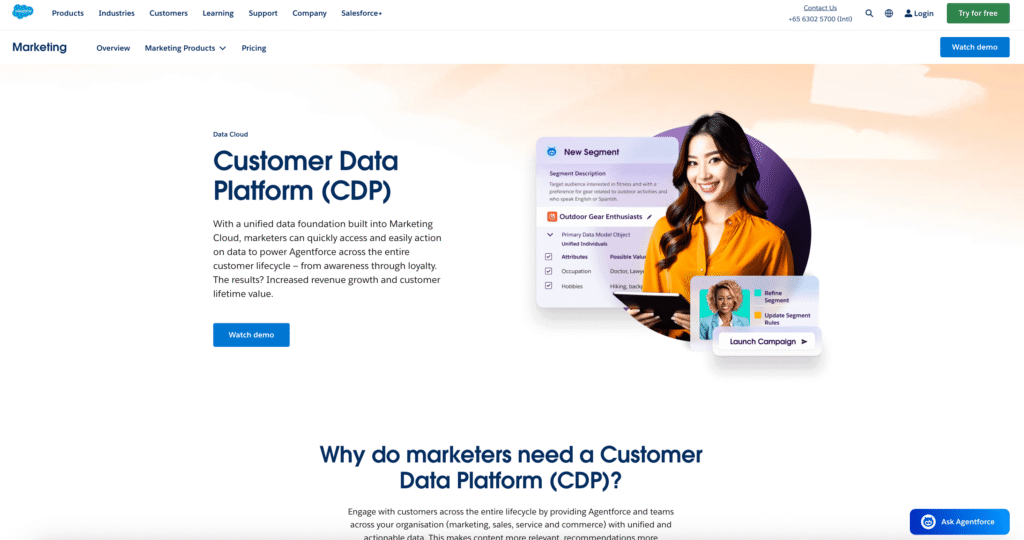
Salesforce Data Cloud is one of the most powerful and comprehensive data management platforms in the market, built to unify customer data across multiple touchpoints and deliver actionable insights through artificial intelligence. Positioned as the evolution of Salesforce’s previous Audience Studio (formerly Krux), Data Cloud serves as the backbone of Salesforce’s ecosystem, enabling businesses to manage, analyze, and activate customer data in real time. In 2026, it continues to be a top choice for enterprises seeking a scalable and intelligent solution for unified data management.
Overview and Core Capabilities
Salesforce Data Cloud is designed to provide organizations with a single, comprehensive view of each customer by connecting CRM data, legacy systems, and third-party sources into one centralized platform. The goal is to eliminate data silos, improve data accuracy, and enhance personalization across marketing, sales, and service functions.
Key core functions include:
- Unified Customer Data – Combines customer information from multiple platforms into a single profile, ensuring consistency and eliminating duplicates.
- Data Harmonization – Automatically standardizes and synchronizes datasets across systems to ensure accuracy and continuity.
- Audience Segmentation – Supports advanced segmentation and targeting using both first-party and cookie-based audiences.
- Seamless Integration – Connects with other Salesforce products such as Sales Cloud, Service Cloud, and Marketing Cloud, ensuring smooth data flow across the ecosystem.
Key Features and Differentiators
Real-Time Unified Customer Profiles
- Salesforce Data Cloud gathers information from multiple channels including web, email, social, and mobile, updating customer profiles in real time.
- This enables businesses to deliver relevant, personalized experiences across the customer journey.
AI-Powered Insights
- The platform leverages Salesforce’s artificial intelligence suite—Einstein Copilot and Agentforce—to offer predictive analytics, automated insights, and next-best-action recommendations.
- By 2025, Salesforce’s AI-driven products contributed nearly $900 million in annual recurring revenue, showcasing the effectiveness of its AI integration.
Comprehensive Reporting and Analytics
- Data Cloud features advanced dashboards and real-time reporting tools to measure performance, monitor KPIs, and evaluate customer engagement.
- The “Metrics on Metrics” functionality simplifies the creation of calculated insights, such as tracking email open rates or purchase frequency per customer, using a clear logical data model.
Enterprise-Grade Security and Compliance
- Built on Salesforce’s secure cloud infrastructure, Data Cloud provides data encryption, role-based permissions, and multi-factor authentication.
- It complies with international data regulations, ensuring safe and compliant data operations across industries such as finance, healthcare, and retail.
Performance and Scalability
Salesforce Data Cloud operates at enterprise scale, maintaining consistent performance for organizations handling millions of customer records. It is optimized for high data loads and complex queries without compromising speed or accuracy.
| Performance Metric | Description | Benchmark |
|---|---|---|
| Average Uptime | Platform availability and reliability | 99.99% uptime |
| Scalability | Ability to support data growth and multi-tenant operations | Seamless horizontal and vertical scaling |
| Data Processing | Real-time updates for unified profiles | Near-instant synchronization |
| Accessibility | Cross-platform usability (desktop & mobile) | Fast load times across devices |
Integration Ecosystem
Salesforce Data Cloud excels in its integration ecosystem, offering seamless connectivity across Salesforce and third-party environments.
- Salesforce Native Integration: Works smoothly with Sales Cloud, Service Cloud, and Marketing Cloud for consistent and unified workflows.
- API-Driven Connections: Through MuleSoft, Data Cloud integrates with external data sources, CRMs, and analytics tools.
- Cross-Cloud Synchronization: Ensures data consistency across customer-facing departments for marketing, service, and commerce.
This strong integration capability allows organizations to maximize data utility without manual transfers or synchronization delays.
Pricing Structure
Salesforce Data Cloud’s pricing varies depending on enterprise requirements and data volume. While it is often available as an add-on to Salesforce’s CRM solutions, its pricing can range widely depending on scale and features.
| Edition | Estimated Range (USD/month) | Notes |
|---|---|---|
| Starter/Pro Suite | $25–$100 per user | Ideal for small and medium businesses |
| Enterprise Suite | $150–$300 per user | Advanced integrations and automation tools |
| Einstein 1/Unlimited Suite | $400–$500 per user | AI-powered features and advanced analytics |
| Data Cloud Add-On | Enterprise-level pricing | Custom pricing based on usage and storage |
While the flexibility in pricing provides scalability, users have reported that the cost structure can be complex, especially when combining multiple Salesforce modules.
User Reviews and Ratings
Salesforce Data Cloud maintains a strong reputation in the industry with consistently high ratings across leading review platforms.
| Review Platform | Average Rating | Total Reviews | User Recommendation |
|---|---|---|---|
| G2 | 4.4 / 5 | 69 | Highly rated for data unification and usability |
| Gartner Peer Insights | 4.4 / 5 | 123 | 76% of users recommend the platform |
Pros:
- Efficient in merging data from multiple systems into a unified view.
- Offers powerful segmentation tools for marketing and audience targeting.
- AI-powered insights enhance productivity and campaign performance.
- Intuitive user interface with extensive reporting options.
Cons:
- High costs and complex pricing structures may be a challenge for smaller organizations.
- Implementation can be time-consuming and requires Salesforce expertise.
- Integration with non-Salesforce platforms may require additional configuration.
Strategic Roadmap and Future Outlook
Salesforce’s roadmap for 2026 is focused on strengthening its artificial intelligence and data automation capabilities across the entire ecosystem. The company aims to embed AI-driven personalization and predictive analytics deeply into workflows, allowing organizations to make faster and smarter decisions.
Future goals include:
- AI Cloud Expansion: Enhanced AI models through Einstein GPT for predictive forecasting and automated recommendations.
- Unified Data Architecture: Deepening integration between Data Cloud and other Salesforce products for seamless data exchange.
- Enhanced Security and Privacy: Continuing to strengthen compliance frameworks and role-based access for enterprise-level users.
Why Salesforce Data Cloud Is One of the Top Data Management Platforms for 2026
Salesforce Data Cloud stands out as one of the best data management platforms due to its unmatched combination of scalability, intelligence, and integration.
- Comprehensive Data Unification: Combines CRM, behavioral, and transactional data into a single view for precision targeting.
- AI-Driven Intelligence: Empowers businesses with predictive analytics and automated insights that improve marketing efficiency.
- Global Integration Power: Seamlessly integrates with Salesforce’s suite of applications and external APIs through MuleSoft.
- Enterprise-Grade Performance: Offers reliable uptime, scalability, and data protection standards that meet global enterprise demands.
- Strategic Innovation: Continuous investment in AI and automation ensures Salesforce remains at the forefront of digital transformation.
With its robust architecture, deep AI integration, and extensive ecosystem support, Salesforce Data Cloud is expected to remain a cornerstone of enterprise data management in 2026—helping organizations convert unified data into actionable intelligence that drives growth and customer success.
4. Adobe Real-Time CDP
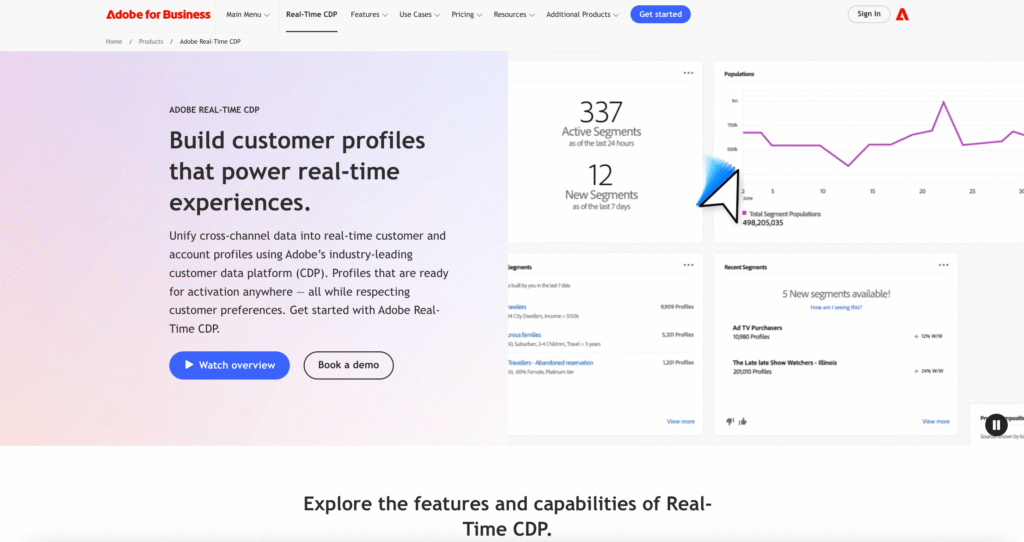
Adobe Real-Time CDP is one of the most advanced and trusted data management platforms in 2026. Developed under the Adobe Experience Platform (AEP), it helps organizations unify, manage, and activate customer data across multiple touchpoints in real time. As a successor to Adobe Audience Manager, this platform combines real-time insights, AI-driven intelligence, and strong data governance, making it a leading choice for both B2B and B2C enterprises.
Overview and Core Capabilities
Adobe Real-Time CDP empowers companies to centralize customer information from online and offline sources. It organizes, normalizes, and unifies data into live customer profiles that support personalization and engagement at scale. Its real-time capability allows brands to respond instantly to customer behavior across marketing channels.
Key highlights include:
- Unified Data Management – Consolidates structured and unstructured data from multiple systems into a single source of truth for accurate audience targeting.
- Real-Time Personalization – Updates customer profiles dynamically to enable timely and relevant messaging across email, web, mobile, and social media.
- Privacy-Centric Architecture – Built with strong data governance controls, ensuring compliance with GDPR, CCPA, and other global privacy laws.
- Cross-Channel Experience Delivery – Connects with marketing, CRM, and analytics tools to offer a unified customer journey experience.
Key Features and Strengths
1. Real-Time Unified Customer Profiles
Adobe Real-Time CDP merges online and offline data sources, providing a single, consistent view of each customer. This unified profile supports seamless personalization, segmentation, and engagement.
2. AI and Predictive Intelligence
Powered by Adobe’s machine learning framework, the platform analyzes patterns to predict customer behavior and recommend optimal marketing actions. Adobe’s AI-driven innovation contributes billions to its annual recurring revenue, reinforcing its industry leadership.
3. Integration and Scalability
Adobe Real-Time CDP integrates natively with Adobe Experience Cloud products and external tools like Google Customer Match, Marketo, and Azure. It handles both real-time and batch data transfers efficiently, supporting businesses of all sizes.
4. Data Privacy and Governance
Privacy is a core component, with built-in access controls and consent management tools that ensure compliance and responsible audience targeting.
5. Customizable Dashboards
Marketers can personalize dashboards to focus on the most relevant metrics, such as audience reach, engagement rates, and conversion data.
Performance and Campaign Scalability
Adobe Real-Time CDP enables advertisers to deliver precise cross-channel campaigns, utilizing look-alike modeling and identity partners to maximize audience reach. Marketers can suppress converted users to optimize ad spend and improve campaign efficiency.
| Metric Type | Description | Purpose |
|---|---|---|
| Impressions | Number of views served to users | Measures exposure |
| Unique Reach | Distinct users reached across campaigns | Assesses audience expansion |
| Average Frequency | Average times a user saw an ad | Evaluates saturation levels |
| Conversion Rate Over Time | Tracks performance trends | Monitors growth and optimization |
These performance indicators help teams measure marketing impact and allocate resources strategically.
Pricing Overview
Adobe Real-Time CDP follows a flexible pricing structure based on:
- Data Volume – Larger datasets increase processing costs.
- Integration Complexity – Advanced or multi-system integrations raise the total cost.
- Customization – Tailored dashboards and machine learning add-ons have separate pricing tiers.
- Support Services – Enterprise-level support packages add further value.
Average costs range between $8,412 to $219,817 per year, with most users paying a median of $62,348. Long-term contracts typically secure better discounts and licensing benefits.
| Pricing Factor | Influence on Cost | Example Scenario |
|---|---|---|
| Data Size | High | Large enterprise with global audiences |
| Integration Requirements | Moderate to High | Connection to CRM and analytics tools |
| Custom Features | Variable | AI segmentation or predictive analytics add-ons |
User Ratings and Industry Recognition
Adobe Real-Time CDP consistently earns positive feedback for its capabilities and reliability:
| Platform | Rating Score | Number of Reviews | Key Feedback |
|---|---|---|---|
| TrustRadius | 8.3 / 10 | 43 Reviews | Excellent data unification and insights |
| Gartner Peer Insights | 4.3 / 5 | 57 Ratings | Strong integration and AI-driven personalization |
Industry experts recognize it as a Leader in the Gartner Magic Quadrant for Customer Data Platforms, reaffirming its enterprise value and technological excellence.
Pros and Cons Summary
| Strengths | Limitations |
|---|---|
| Real-time customer data integration | Complex setup process |
| AI-powered predictive analytics | Expensive for small and mid-size companies |
| Seamless integration within Adobe ecosystem | Requires specialized training for full utilization |
| Strong privacy and governance capabilities | Time-consuming initial deployment |
Future Outlook and Innovation Roadmap
Adobe is investing heavily in expanding AI-driven customer insights and automation within its Experience Platform. A notable addition in 2025–2026 is the Data Insights Agent, which introduces enhanced conversational analytics through tools like the Brand Brain and Enhanced AI Assistant.
Planned advancements include:
- Unified AI Interface – Centralized intelligence hub for data analytics and automation.
- Smarter Customer Journey Orchestration – Native AI tools guiding real-time campaign decisions.
- Delayed Dataset Export Updates – Extended timeline to September 2025 for improved flexibility.
Conclusion
Adobe Real-Time CDP continues to lead the customer data management landscape in 2026 due to its unmatched combination of real-time processing, AI intelligence, and strong privacy framework. For enterprises seeking to unify fragmented data sources, personalize customer experiences, and future-proof marketing operations, this platform stands as one of the most complete and reliable solutions available today.
5. Twilio Segment
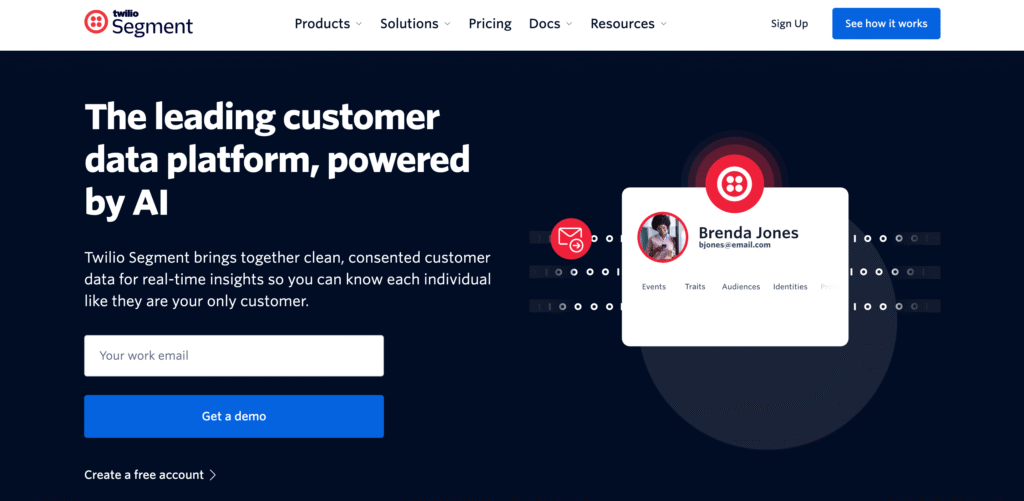
Twilio Segment continues to be one of the top-performing Data Management Platforms (DMP) and Customer Data Platforms (CDP) in 2026. Known for its flexibility, scalability, and intelligent data unification features, it helps organizations turn customer interactions into valuable insights that power personalized experiences. Recognized as a Leader in the Gartner Magic Quadrant for Customer Data Platforms, Twilio Segment has built a strong reputation among enterprises that rely on real-time data integration and AI-driven analytics to make informed business decisions.
Overview and Core Capabilities
Twilio Segment stands out because of its event-based architecture, which tracks every customer action—such as clicks, purchases, or form submissions—as a data event. This approach allows businesses to create highly detailed and identity-resolved customer profiles that can be used for marketing, analytics, and customer experience optimization.
Its platform is built with interoperability and flexibility in mind, allowing organizations to integrate it with existing tools and systems rather than being locked into a single vendor ecosystem. It supports both B2C and B2B environments, making it suitable for a wide range of industries, from retail and e-commerce to SaaS and finance.
Main strengths include:
- Unified Data Collection and Activation – Twilio Segment collects data from multiple touchpoints and unifies it into a single, real-time customer profile.
- Composable Architecture – It follows the MACH (Microservices, API-first, Cloud-native, and Headless) framework, enabling companies to build modular, scalable data solutions.
- Privacy and Security – Built with strong governance tools and consent management capabilities to comply with GDPR and other global data privacy regulations.
- Scalable Data Infrastructure – Optimized for handling high data volumes, supporting real-time synchronization with large data warehouses such as Snowflake, Redshift, and BigQuery.
Key Features and Advantages
1. Real-Time Customer Profile Unification
Twilio Segment consolidates data from web, mobile, and offline channels to provide a single customer profile that updates instantly as new information is captured. This helps marketers deliver consistent experiences across all digital touchpoints.
2. Extensive Integration Ecosystem
With over 300 pre-built connectors, Segment simplifies integration with popular analytics, CRM, and marketing automation tools. The platform’s bi-directional data flow allows businesses to share and retrieve information seamlessly without manual configuration.
| Integration Type | Supported Platforms | Key Benefit |
|---|---|---|
| Data Warehouses | Snowflake, BigQuery, Redshift | Real-time synchronization and scalability |
| CRMs & Marketing Tools | HubSpot, Salesforce, Marketo | Streamlined audience segmentation and activation |
| Analytics Tools | Google Analytics, Amplitude, Mixpanel | Unified reporting and behavioral tracking |
3. AI-Driven Personalization
The platform’s Predictive Traits feature leverages machine learning to forecast customer behaviors, such as purchase intent or churn probability. Adoption of this capability has grown by over 57% year-over-year, reflecting its value in predictive marketing and retention campaigns.
4. Robust Governance and Privacy Management
Twilio Segment offers enterprise-grade data governance features, including consent tracking, field-level permissions, and automatic data masking. These controls help businesses maintain transparency and compliance while still using customer data effectively.
5. Composable and Future-Proof Design
Segment’s composable architecture aligns with the MACH Alliance principles, ensuring that businesses can easily adapt their tech stack as new tools emerge without rebuilding their entire system.
Performance and Scalability
Twilio Segment is designed for organizations dealing with high data volumes and needing real-time activation. When integrated with major data warehouses, it can handle billions of data events per day while maintaining stability and accuracy.
| Metric Type | Description | Impact on Performance |
|---|---|---|
| Data Events Processed | Tracks customer interactions as data points | Enables precise behavioral insights |
| Real-Time Processing | Immediate data synchronization | Improves personalization and targeting speed |
| Integration Load Handling | Manages simultaneous data transfers | Maintains system reliability during peak loads |
This scalability allows businesses to personalize customer journeys for millions of users with minimal latency.
Pricing Overview
Twilio Segment offers flexible pricing models tailored to business size and data usage. Costs are primarily determined by the number of Monthly Tracked Users (MTUs), data volume, and integration complexity.
| Pricing Tier | Typical Cost Range (per year) | Key Features |
|---|---|---|
| Growth Plan | $14,985 – $53,544 | Core data collection and integrations |
| Business Plan | $53,544 – $182,324 | Advanced governance, machine learning, and scalability |
| Enterprise Plan | Custom Pricing | Tailored features for high-volume, global organizations |
Average buyers save up to 17% through negotiation, with the median annual cost around $53,544. Discounts between 10% to 52% are often available for multi-year commitments, and standard contract renewals can be reduced from 8% to 3% through long-term agreements.
Minimum contract requirements start at 50,000 Monthly Tracked Users (MTUs) per year, making it more suited for medium to large enterprises.
User Ratings and Feedback
Twilio Segment is well-reviewed by industry experts and users for its ease of use, scalability, and data accuracy.
| Platform | Rating | Reviews Count | Highlights |
|---|---|---|---|
| G2 | 4.5 / 5 | 557 Reviews | Excellent integration and ease of setup |
| Gartner Peer Insights | 4.5 / 5 | 91 Ratings | High reliability and AI-driven personalization |
Users highlight the platform’s ability to unify customer data efficiently and integrate seamlessly with CRMs, analytics tools, and marketing systems.
Pros
- Intuitive user interface and minimal engineering dependency
- Strong integration ecosystem with 300+ connectors
- Supports identity resolution and predictive modeling
- Enables quick creation of custom audiences
Cons
- Premium pricing may not suit small businesses
- Occasional integration challenges with complex systems
- Requires some training to fully leverage advanced AI features
Strategic Roadmap and Future Outlook
Twilio Segment’s strategic direction focuses on advancing interoperability, predictive intelligence, and open architectures. The 2025–2026 roadmap highlights a shift toward deeper collaboration between data warehouses and CDPs, improving how customer data is stored, accessed, and activated in real time.
Future initiatives include:
- Enhanced Predictive AI Models – Improving personalization and customer journey forecasting.
- Expanded MACH Alliance Collaboration – Further aligning with open and modular technology standards.
- Real-Time Data Governance Enhancements – Adding new tools for consent tracking and AI transparency.
Conclusion
Twilio Segment has proven itself as one of the Top 10 Best Data Management Platforms for 2026 by offering real-time data unification, advanced AI capabilities, and strong interoperability. Its commitment to flexibility, scalability, and open architecture makes it a preferred choice for organizations seeking to create personalized, data-driven customer experiences. Through its growing integration ecosystem, predictive analytics, and privacy-first design, Twilio Segment remains a future-ready solution for modern digital enterprises.
6. LiveRamp
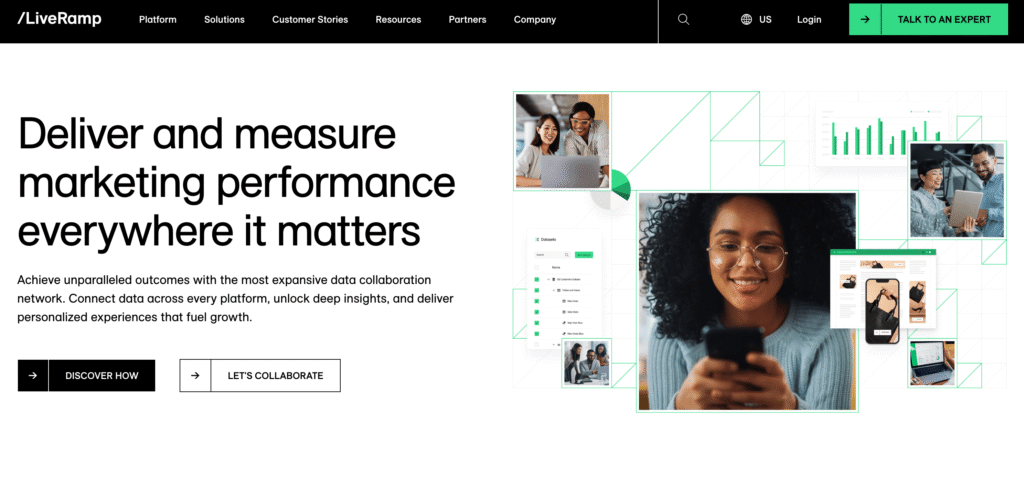
LiveRamp stands out as one of the Top 10 Best Data Management Platforms (DMPs) for 2026 due to its strong capabilities in identity resolution, secure data collaboration, and privacy-first data activation. Positioned as a trusted global leader in data connectivity, LiveRamp empowers enterprises to unify, analyze, and activate customer data seamlessly across digital and offline environments. Holding an 11% market share in the Identity Management and Resolution Software sector as of 2025, LiveRamp continues to shape the future of data-driven marketing and customer engagement.
Overview and Core Capabilities
LiveRamp’s primary mission is to enable businesses to use data safely and efficiently while enhancing marketing effectiveness and customer understanding. Unlike traditional DMPs that focus only on online data, LiveRamp specializes in connecting offline Personally Identifiable Information (PII) with online anonymous identities. This capability bridges the gap between digital and real-world data, enabling organizations to reach customers across multiple platforms in a privacy-compliant and identity-resolved manner.
Its unified data infrastructure supports:
- Data Collaboration and Activation – Businesses can securely share and activate data across multiple partners, including media networks and digital advertising platforms.
- Cross-Channel Insights – LiveRamp connects disparate data sources to provide a holistic customer view across television, mobile, social, and web channels.
- Privacy-First Data Handling – The platform embeds compliance measures for GDPR and CCPA, ensuring that companies maintain trust while achieving data-driven growth.
- Scalable Ecosystem – With more than 900 advertisers, publishers, and data partners, LiveRamp provides one of the most extensive and interoperable data networks in the industry.
Key Features and Advantages
Identity Resolution with RampID
RampID is the foundation of LiveRamp’s identity framework. It enables businesses to unify fragmented customer databy linking various identifiers—emails, cookies, and device IDs—into a single, persistent profile. This allows marketers to accurately target audiences even in a cookieless environment, maintaining reach and personalization.
Data Onboarding and Enrichment
Organizations can upload offline customer data into the platform and enhance it with additional attributes from LiveRamp’s data marketplace. This process provides deeper insights into customer behavior, preferences, and purchasing trends.
Cross-Media Intelligence
Introduced in early 2025, Cross-Media Intelligence gives advertisers a deduplicated, unified view of performance across channels, improving ROI measurement. It has been proven to accelerate data insights by four times faster and increase marketing ROI by up to 25%.
Privacy and Compliance Controls
LiveRamp incorporates strong anonymization tools and permission-based data access, helping organizations comply with evolving privacy laws while still conducting personalized campaigns.
Omnichannel Data Activation
Marketers can activate audiences across major digital and offline channels, including CTV (Connected TV), mobile apps, and retail media networks. This enables more effective campaign orchestration and engagement tracking.
Performance and Scalability Metrics
LiveRamp consistently improves its platform performance and data accuracy to meet enterprise demands. Its network strength and real-time analytics capabilities support massive data volumes while maintaining data quality.
| Metric Type | 2025 Performance Data | Impact on Businesses |
|---|---|---|
| Match Rate Growth | +10% year-over-year | Better accuracy in linking identities and improving ad targeting |
| Time-to-Insight | 4x faster analysis via Cross-Media Intelligence | Quicker data activation and campaign optimization |
| Collaboration Network | 900+ partners globally | Scalable data sharing across industries and channels |
These performance improvements make LiveRamp a top choice for brands that require speed, precision, and scalabilityin managing vast amounts of customer data.
Integration Ecosystem
LiveRamp’s open ecosystem supports a broad range of integrations, making it one of the most versatile DMPs in the market.
| Integration Type | Example Partners | Functionality |
|---|---|---|
| Marketing Platforms | The Trade Desk, Google DV360, Spotify | Enables authenticated audience targeting and campaign activation |
| Analytics Tools | Oracle DMP, Neustar Unified Analytics | Enhances marketing ROI tracking and customer insights |
| Cloud and Data Warehouses | AWS, Snowflake | Supports native identity resolution and secure data collaboration |
Through these integrations, LiveRamp empowers marketers to activate high-value audiences across major ad networks and measure outcomes more effectively.
Pricing Structure and Tiers
LiveRamp offers customized pricing tailored to an organization’s data volume, channel usage, and collaboration needs. The company uses a percentage-of-media-spend model for distribution to social platforms, which typically ranges as follows:
| Segment Type | Pricing Model | Description |
|---|---|---|
| Standard Segments | 10% or 15% of media spend | Ideal for general audience distribution |
| Custom Segments | 15% of media spend | Used for unique, data-driven audience targeting |
Although some users note that LiveRamp’s pricing can be on the higher side, its enterprise-grade performance, privacy-first design, and scalability justify the investment. The company’s financial performance also reflects strong growth, with:
- $729 million in TTM revenue as of December 2024
- 16% year-over-year revenue growth
- 125 customers generating over $1 million annually in subscription revenue
User Ratings and Reviews
LiveRamp maintains positive reviews across major industry platforms, with users praising its robust identity resolution, data collaboration tools, and support quality.
| Review Platform | Rating | Number of Reviews | Summary of Feedback |
|---|---|---|---|
| G2 | 4.2 / 5 | 109 | Excellent identity linkage and secure data management |
| TrustRadius | 9.7 / 10 | 15 | High satisfaction with accuracy and customer support |
| Gartner Peer Insights | 5.0 / 5 | 1 | Strong performance in large-scale data environments |
Pros
- Connects offline and online data efficiently for holistic audience targeting
- High flexibility and interoperability across data ecosystems
- Advanced cookieless targeting and CRM data activation
- Reliable customer support and documentation
Cons
- Pricing may be expensive for smaller organizations
- Interface can feel complex for new users
- Processing large data files may occasionally cause delays
Strategic Roadmap and Future Outlook
LiveRamp’s roadmap for 2026 emphasizes continued innovation in AI-driven data collaboration, media measurement, and privacy-centric architecture. The company aims to expand its ecosystem and enhance automation through deeper integrations with leading data and media platforms.
Key upcoming initiatives include:
- Enhanced RampID Resolution within AWS and Snowflake to improve identity mapping speed and accuracy.
- New Conversion API Integrations for platforms like Amazon, TikTok Events API, and Yahoo! to strengthen omnichannel activation.
- Expansion of Cross-Media Intelligence to additional industries, including commerce media and retail sectors.
- AI-Enabled Data Governance Tools that provide transparent, compliant, and intelligent data handling for marketers.
Conclusion
LiveRamp remains one of the Top 10 Best Data Management Platforms for 2026 because of its strong focus on data connectivity, privacy compliance, and innovation. Its RampID technology, Cross-Media Intelligence, and interoperable ecosystem allow organizations to maximize the value of their data assets in a cookieless, privacy-conscious environment. By empowering brands to build trust, unify fragmented data, and deliver personalized experiences across every channel, LiveRamp continues to be a cornerstone in the global data management and marketing landscape.
7. Lotame
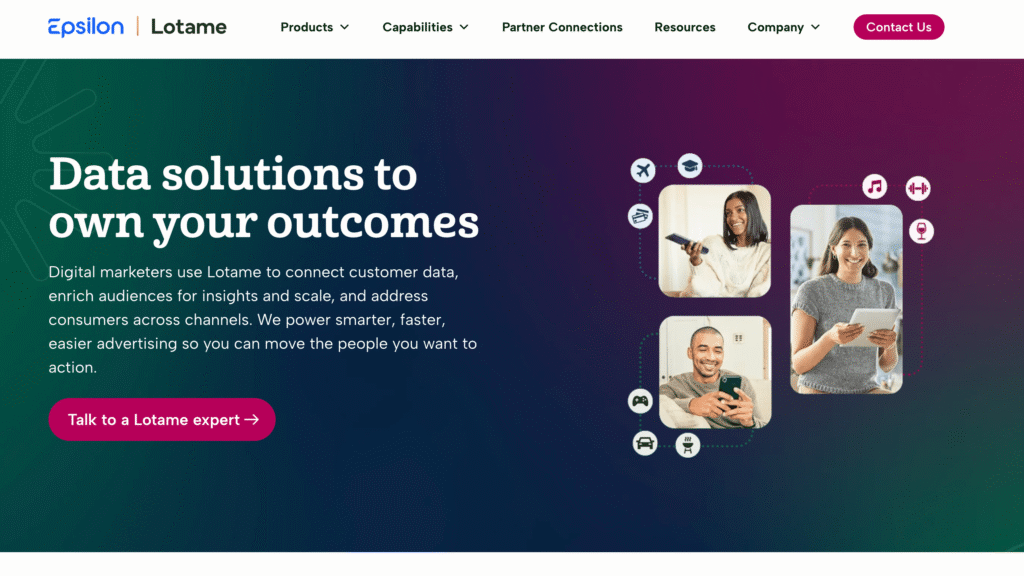
Lotame is recognized as one of the Top 10 Best Data Management Platforms (DMP) for 2026 due to its powerful ability to unify, enrich, and activate audience data for digital advertising and marketing optimization. Designed to help businesses better understand their consumers and enhance their advertising return on investment, Lotame stands out as a “customer data accelerator,” making it a vital tool for companies seeking to manage and leverage data effectively in a privacy-driven digital world.
Lotame’s DMP continues to attract attention in the global data management space, holding a 2.8% market share in 2025. Its Spherical Platform remains a leading solution for brands, publishers, and agencies aiming to make data-driven decisions across channels.
Key Overview and Core Capabilities
• The Lotame Spherical Platform serves as a next-generation data engine that unifies first-party, second-party, and third-party data to create a panoramic and actionable understanding of audiences.
• It empowers advertisers and marketers to gain deep insights into consumer behavior, improve personalization strategies, and strengthen audience engagement through precise targeting.
• Lotame emphasizes second-party data collaboration, enabling businesses to access reliable external datasets to complement their in-house customer data for better campaign outcomes.
• The platform’s interoperability across data warehouses, ad servers, DSPs, and marketing systems ensures scalability and flexibility for different business needs.
Key Features and Competitive Differentiators
• Audience Segmentation and Modeling: Lotame uses artificial intelligence and machine learning to identify behavioral patterns, build lookalike audiences, and enable smarter audience expansion. This ensures marketers can find and engage potential customers who are most likely to convert.
• Identity-Powered Data Activation: Businesses can activate their unified audiences across different digital environments—social, mobile, connected TV, and display advertising—while maintaining data privacy and regulatory compliance.
• Unified First-Party Data Management: Lotame allows companies to collect and enrich customer data from multiple sources, combining offline and online information to create accurate and complete customer profiles.
• Data Quality and Governance: The platform features built-in data monitoring and quality control mechanisms to ensure reliable, clean, and compliant data usage.
• Cross-Screen Data Integration: Lotame provides seamless cross-channel activation capabilities, helping brands target consumers consistently across devices and media channels.
Performance and Scalability Metrics
| Metric | Lotame Performance Indicator |
|---|---|
| Average Implementation Time | 3 months |
| ROI Realization Period | 12 months |
| System Scalability | Supports large-scale integrations with DSPs, SSPs, and ad platforms |
| Data Processing Speed | Handles segmentation and modeling faster than manual data processing |
• Lotame’s flexible architecture ensures performance stability as data volumes increase, supporting organizations that handle billions of data signals daily.
• The system’s scalability enables advertisers to execute real-time personalization and maintain consistent data quality across campaigns.
Integration Ecosystem
• Lotame offers a wide integration network that connects directly with marketing, analytics, and advertising systems.
• Strategic partnerships with companies like Survata allow for audience validation and research, enabling businesses to measure and improve audience accuracy.
• The DMP’s interoperability ensures easy synchronization with third-party applications, helping organizations avoid data silos.
Pricing Structure and Plans
| Pricing Element | Description |
|---|---|
| Pricing Model | Custom-based, depends on data usage and features |
| Cost Perception | Rated as “very expensive” ($$$$$) |
| Discounts | Average 12% reported |
| Flexibility | Allows clients to pay only for the specific products or services needed |
Lotame’s pricing flexibility ensures that businesses, from enterprises to growing agencies, can tailor their investment based on data volume and campaign complexity.
User Reviews and Market Ratings
| Review Platform | Rating | Number of Reviews |
|---|---|---|
| G2 | 4.4 / 5 | 116 |
| TrustRadius | 8.8 / 10 | 15 |
| SaaSworthy | 4.6 / 5 | 91 |
Users consistently highlight Lotame’s ability to unify fragmented data sources and drive advertising efficiency. Its intuitive interface and strong audience segmentation tools make it a top choice for marketing teams seeking actionable intelligence from complex datasets.
Pros and Advantages
• Efficient audience segmentation and data-driven insights that boost marketing ROI.
• Seamless integration with existing advertising and marketing systems.
• Strong focus on cross-device and omnichannel audience activation.
• Simplified interface for data enrichment and audience management.
Cons and Limitations
• Can be expensive for smaller organizations with limited data budgets.
• Occasional delays in data processing or report generation.
• Requires training to fully utilize advanced segmentation and analytics features.
Strategic Roadmap and Future Outlook
Lotame’s long-term vision focuses on helping businesses transition smoothly into a cookieless and privacy-first advertising landscape. Its strategic direction for 2026 emphasizes:
• Expanding the use of first-party and second-party data to mitigate the loss of third-party cookies.
• Enhancing interoperability with global adtech and martech ecosystems.
• Introducing more advanced artificial intelligence models for predictive audience analytics.
• Strengthening privacy governance and compliance with emerging global regulations.
As data volumes worldwide are expected to reach over 180 zettabytes by 2025, Lotame is positioning itself as a critical player that bridges data strategy, identity resolution, and real-time audience activation. Its strong market presence, performance capabilities, and adaptability make it one of the top DMPs shaping the digital marketing landscape in 2026.
8. The Trade Desk
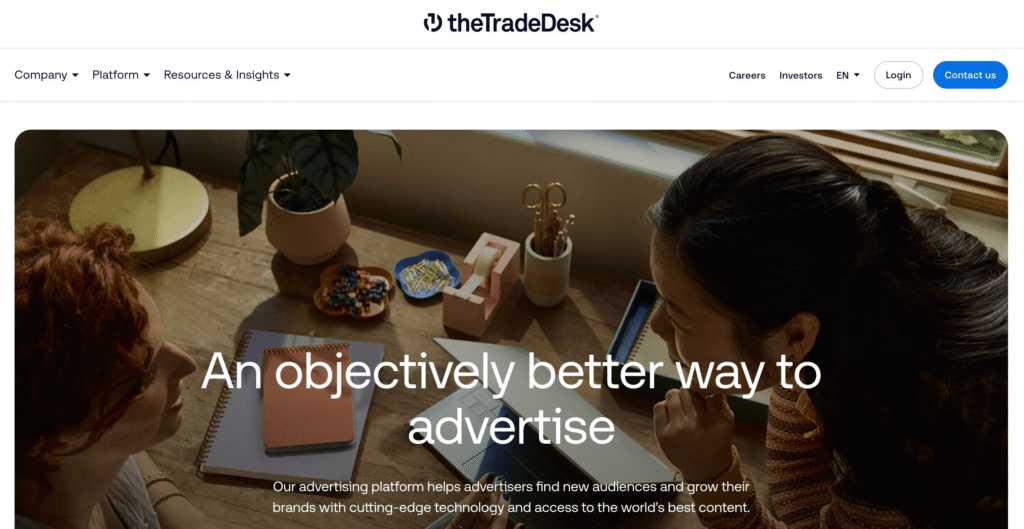
The Trade Desk stands out as one of the Top 10 Best Data Management Platforms (DMP) for 2026 because of its advanced, data-driven approach to digital advertising and its ability to empower marketers with unmatched transparency, precision, and control. It is a global leader in programmatic advertising technology, enabling brands to efficiently plan, buy, and manage ads across every major digital channel, from display and video to mobile and connected TV (CTV). By combining artificial intelligence with a vast ecosystem of integrations, The Trade Desk has become the preferred choice for enterprises seeking smarter and more measurable advertising outcomes.
Overview and Core Capabilities
• The Trade Desk operates as an independent Demand-Side Platform (DSP) designed for advertisers who value transparency and data control.
• It allows businesses to access, analyze, and optimize digital ad campaigns across multiple channels using a single, intuitive platform.
• The company’s mission is to give marketers greater visibility into where their advertising budget goes and to ensure that every dollar spent delivers measurable value.
• With a strong market presence, it holds 1.78% of the global DMP market and serves over 860 enterprise customers as of 2025.
The platform’s architecture focuses on helping advertisers make smarter, faster, and more informed decisions using real-time insights and predictive analytics. This combination of precision targeting, data integration, and transparency makes it a dominant player in the advertising technology space.
Key Features and Differentiators
• AI Optimization (Koa): The platform’s artificial intelligence engine, Koa, analyzes billions of data points in real time to enhance campaign effectiveness, forecast performance, and recommend optimization strategies.
• Omnichannel Campaign Management: The Trade Desk centralizes all advertising efforts into one interface, enabling users to manage CTV, video, display, audio, and mobile campaigns seamlessly from a single dashboard.
• Advanced Targeting Tools: Offers granular control with over 1,000 targeting variables, such as geography, demographics, time of day, weather, and device type. These tools enable advertisers to reach the right audience under the right conditions.
• Real-Time Bidding (RTB): The platform supports automated, real-time bidding to purchase digital ad inventory efficiently, ensuring that advertisers pay the right price for every impression.
• Decision Power and Relevance Metrics: Unique scoring systems evaluate ad inventory quality and audience match, giving marketers clarity and confidence before committing their budget.
Performance and Scalability Metrics
| Performance Metric | Indicator Value (2025) | Growth Rate |
|---|---|---|
| Annual Revenue Growth | 25.4% year-on-year | Higher than competitors’ 9.9% average |
| Net Income Growth | 60.07% | Outpaced competitors by 6% |
| Customer Retention Rate | 93% | Industry-leading performance |
| Market Share | 1.78% in DMP category | Expanding annually |
• The Trade Desk’s architecture is built for scale, supporting global advertisers who manage millions of ad impressions every day.
• The platform consistently delivers high uptime, fast load speeds, and low latency for campaign reporting and optimization.
Integration Ecosystem
• The Trade Desk connects seamlessly with hundreds of data, inventory, and publisher partners, creating one of the largest integration networks in the industry.
• It supports Enterprise APIs for custom workflows and Open APIs for connecting proprietary first-party data, offering flexibility for large organizations.
• Integration partners include major ad exchanges, DSPs, SSPs, and cloud-based analytics systems, ensuring a connected and efficient advertising ecosystem.
Pricing Structure and Tiers
| Pricing Component | Description |
|---|---|
| Pricing Model | Cost Per Mille (CPM) |
| Platform Fee | Typically around 20% of media spend |
| Minimum Monthly Spend | Between $300,000 and $1,000,000 |
| Additional Costs | Lookalike modeling, data CPMs, creative services, and cross-device targeting |
• The platform is positioned as a premium enterprise solution, making it ideal for large-scale advertisers with high-volume campaigns.
• Despite its higher cost, businesses often justify the expense through significantly improved targeting accuracy and return on ad spend (ROAS).
User Reviews and Ratings
| Review Platform | Rating | Number of Reviews |
|---|---|---|
| G2 | 4.5 / 5 | 114 |
| SaaSworthy | 4.4 / 5 | 157 |
| Gartner Peer Insights | 4.4 – 4.6 (across categories) | 92 |
• 93% of users recommend The Trade Desk for its ease of use, intelligent campaign automation, and transparent reporting tools.
• Many reviewers highlight its unmatched targeting flexibility, real-time insights, and strong customer support.
Pros and Advantages
• Exceptional AI-powered optimization for campaign efficiency and predictive analytics.
• Centralized omnichannel management that simplifies multi-platform advertising.
• Highly customizable audience targeting with a wide variety of data attributes.
• Transparent reporting that gives advertisers full control over spending and performance.
• Reliable customer support and strong community training through “The Trade Desk Edge Academy.”
Cons and Limitations
• Higher cost structure limits accessibility for small businesses.
• Reporting and data dashboards can be complex for beginners.
• Occasional technical glitches or delays in loading large datasets.
• Requires time and training to master advanced functionalities.
Strategic Roadmap and Future Outlook
The Trade Desk continues to set industry standards by focusing on the future of data-driven advertising and privacy-first marketing. Its roadmap for 2026 includes:
• Expanding its “Unified ID 2.0” initiative to offer a cookie-free identity framework, addressing privacy concerns and data regulation changes.
• Enhancing integration with streaming platforms and connected TV (CTV) networks to capture the rapidly growing video advertising market.
• Investing in metadata and content signal layering to improve precision targeting and reduce wasted impressions.
• Developing more advanced AI algorithms for adaptive media planning and automated campaign optimization.
The Trade Desk’s consistent innovation, performance scalability, and leadership in identity-based advertising make it one of the top Data Management Platforms shaping the future of programmatic marketing in 2026. Its transparent business model and powerful data tools continue to empower advertisers worldwide to deliver impactful, measurable campaigns across every digital channel.
9. Permutive
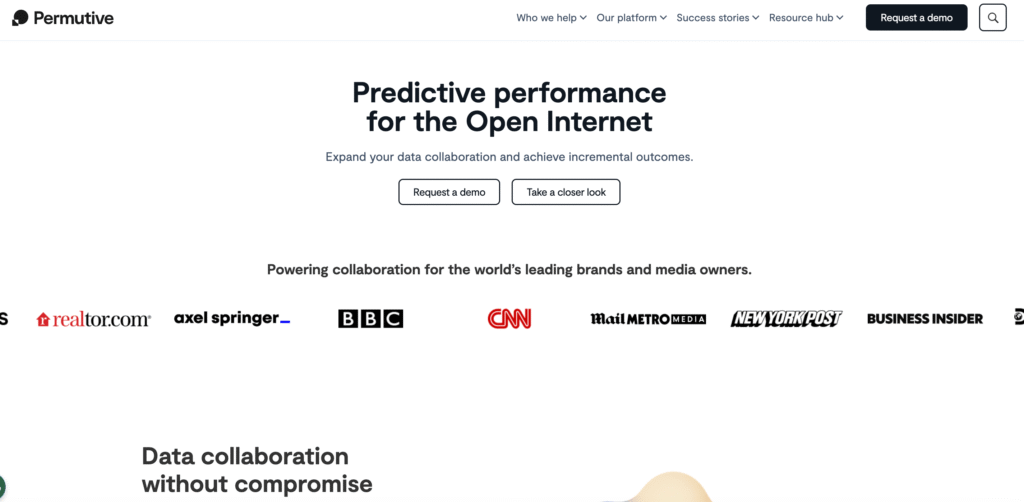
Permutive is widely recognized as one of the top Data Management Platforms (DMP) for 2026 because of its advanced privacy-first architecture, real-time processing capabilities, and strong focus on publisher empowerment. It provides a powerful combination of data security, personalization, and monetization tools designed for businesses aiming to manage audience data responsibly and effectively in a post-cookie digital world.
Introduction and Core Overview
Permutive serves as a next-generation audience data platform that helps companies, particularly publishers and advertisers, collect, analyze, and activate user data without compromising privacy. In an era where privacy regulations such as GDPR and CCPA are reshaping marketing strategies, Permutive’s edge technology offers a compliant yet performance-driven solution. This privacy-centric approach helps organizations build trust with users while maintaining data-driven growth.
Why Permutive Stands Out as a Top Data Management Platform for 2026
Privacy-First Audience Data Management
- Permutive is built on a foundation of privacy compliance, aligning fully with global regulations like GDPR and CCPA.
- Businesses can confidently manage audience data, ensuring that no sensitive user information leaves the user’s device, reducing the risk of breaches.
- Its privacy-first design helps companies maintain user trust and transparency—key advantages in today’s digital advertising ecosystem.
Real-Time Edge Data Processing
- Permutive uses edge processing, meaning data is processed directly on the user’s device rather than on centralized servers.
- This allows faster audience segmentation, immediate insight generation, and more responsive personalization strategies.
- Edge processing ensures minimal latency, making Permutive highly scalable even in environments with strict privacy restrictions.
Advanced Audience Segmentation
- The platform enables businesses to build detailed audience segments using real-time behavioral and contextual data.
- Marketers can customize campaigns based on user preferences, boosting engagement and ad relevance.
- These segmentation tools allow publishers to deliver hyper-personalized experiences, increasing conversion rates and retention.
Complete Data Ownership and Control
- Unlike many DMPs that rely heavily on third-party cookies or external data sets, Permutive gives companies complete ownership of their first-party data.
- This autonomy ensures that organizations maintain data sovereignty and transparency, improving the integrity of analytics.
Publisher-Focused Architecture
- Permutive is specifically designed with publishers in mind.
- It supports them in building their own data ecosystems, helping monetize audiences effectively while staying compliant.
- Studies show that publishers using Permutive can increase advertising revenue up to four times through optimized data activation.
Performance and Scalability Matrix
| Feature | Description | Benefit to Business |
|---|---|---|
| Edge Processing Technology | Processes data on the user’s device | Faster decisions and improved privacy |
| Real-Time Audience Updates | Continuous data refresh for live campaigns | Higher ad relevance and engagement |
| High Scalability Architecture | Handles millions of data points efficiently | Suitable for enterprise-grade operations |
| Compliance Assurance | GDPR and CCPA aligned data policies | Trustworthy and regulation-ready framework |
Integration Ecosystem
Permutive integrates seamlessly with major cloud and marketing ecosystems, ensuring smooth data flow across multiple tools:
- Cloud Integrations: Google Cloud, AWS
- Marketing Platforms: Salesforce Marketing Cloud, Google Analytics, AppNexus DSP
- Advertising Networks: Facebook Pixel, The Trade Desk, Pinterest
- Ad Tech Compatibility: Prebid frameworks and Google Ad Manager (GAM)
These integrations allow businesses to unify their marketing, analytics, and advertising data across all touchpoints for a consistent and efficient workflow.
Pricing Structure and Business Value
- Permutive follows a customized pricing model based on the organization’s data volume, usage, and integration needs.
- While considered premium-priced, its performance, compliance, and revenue potential justify the investment for large-scale publishers and marketers.
- The company’s revenue is estimated between $10M and $50M, supported by $75M in total funding, showcasing strong financial stability and innovation investment.
User Satisfaction and Market Feedback
| Platform | Overall Rating | Number of Reviews | Key Highlights |
|---|---|---|---|
| G2 | 4.5 / 5 | 82 Reviews | Strong customer service, privacy-first design |
| SoftwareFinder | 4.8 / 5 | 17 Reviews | Real-time insights, intuitive segmentation tools |
Positive Aspects
- Users commend Permutive’s edge-based privacy architecture, accuracy of segmentation, and high responsiveness.
- Its support team is described as proactive, technically skilled, and highly responsive to user feedback.
Challenges and Limitations
- Some users mention limited accuracy in predictive models and basic batch import functionality for complex configurations.
- The cost of the platform may be higher compared to other DMPs, making it more suitable for medium to large enterprises.
Strategic Roadmap and Future Outlook for 2026
Permutive’s future strategy revolves around three key directions shaping its leadership position in 2026:
- Curation at the Core: Simplifying how advertisers and publishers create curated audience packages for more targeted advertising.
- First-Party Data Collaboration: Enabling brands and publishers to share and activate data safely in real-time through secure environments.
- AI-Powered Optimization: Using artificial intelligence to improve ad targeting accuracy, click-through rates (CTR), and campaign efficiency.
Through these initiatives, Permutive continues to evolve into a fully collaborative and AI-augmented DMP ecosystem, setting new benchmarks in the privacy-first data management space.
Overall Assessment
Permutive remains a top-tier DMP for 2026 because it successfully bridges privacy compliance with high-performance audience management. Its ability to empower publishers, manage first-party data effectively, and provide real-time insights positions it as a key player in the evolving landscape of digital advertising and data-driven marketing.
10. Tealium Customer Data Hub

Tealium Customer Data Hub is one of the top Data Management Platforms (DMP) for 2026 because of its powerful real-time data streaming capabilities, extensive integration ecosystem, and strong privacy compliance framework. As a recognized leader in the Gartner Magic Quadrant for Customer Data Platforms, Tealium stands out for helping organizations unify, manage, and activate customer data to enhance personalization, drive marketing performance, and support AI-powered decision-making.
Introduction and Platform Overview
Tealium Customer Data Hub is designed to help businesses collect, clean, and connect customer data from multiple sources, including websites, mobile apps, servers, IoT devices, and kiosks. By transforming fragmented data into a unified customer view, Tealium enables organizations to deliver personalized experiences, strengthen customer loyalty, and optimize marketing efficiency. Its platform combines tag management, API connectivity, machine learning capabilities, and real-time data orchestration into one intelligent system.
Why Tealium Customer Data Hub is Among the Best DMPs for 2026
Real-Time Data Collection and Activation
- Tealium operates as a live data streaming engine, allowing enterprises to gather and process customer data instantly.
- Businesses gain immediate insights into customer behavior, allowing faster campaign adjustments and better audience targeting.
- Real-time activation ensures that data is continuously used for personalization and performance tracking without delays.
Extensive Integration Ecosystem
- Tealium provides more than 1,300 pre-built integrations with marketing platforms, CRMs, analytics tools, and ad networks.
- The platform seamlessly connects with systems like Salesforce, Google Ads, HubSpot, and Adobe Experience Cloud, reducing integration complexity.
- This broad connectivity ensures that businesses can synchronize customer profiles and deliver consistent messaging across all digital touchpoints.
AI-Powered Data Intelligence
- Tealium integrates artificial intelligence and machine learning to analyze customer data patterns and predict future behaviors.
- These AI-driven insights help marketers make data-backed decisions, optimize customer journeys, and improve return on ad spend (ROAS).
- The platform’s intelligent algorithms enhance segmentation accuracy, driving better campaign results and customer engagement.
Comprehensive Privacy and Consent Management
- Tealium includes a built-in Consent Management Platform (CMP), which centralizes user consent collection and enforcement across all channels.
- The CMP ensures full compliance with global regulations such as GDPR and CCPA.
- This privacy-first approach builds brand trust and reduces regulatory risks for organizations operating in sensitive industries.
Performance, Scalability, and Business Impact
| Performance Metric | Result or Benefit | Real-World Example |
|---|---|---|
| Real-Time Processing | Instant audience activation | Enables adaptive marketing responses |
| Return on Ad Spend (ROAS) | Up to +25% improvement through CAPI integrations | L’Oréal achieved 22%+ higher campaign conversion rates |
| Conversion Rate Optimization | Boosts engagement through unified data | TUI saw a 29% increase in conversions and 18% boost in ROAS |
| Scalability | Enterprise-grade infrastructure | Handles large data volumes without latency |
Tealium’s architecture ensures reliable performance even for organizations managing millions of customer interactions daily. Its server-side and client-side tools allow flexible data handling, making it suitable for large-scale operations with complex marketing ecosystems.
Integration Ecosystem Summary
| Integration Category | Example Platforms/Tools | Key Benefit |
|---|---|---|
| CRM and Marketing Systems | Salesforce, HubSpot, Adobe Experience Cloud | Unified data for personalized campaigns |
| Advertising Platforms | Google Ads, Facebook Ads, LinkedIn Campaigns | Enhanced audience targeting and retargeting |
| Analytics Tools | Google Analytics, Mixpanel, Tableau | Stronger data-driven insights |
| Server-Side Technologies | Node.js, AWS, Azure | Secure and scalable integrations |
Pricing Model and Enterprise Value
- Tealium follows an enterprise-level pricing model based on data volume, number of profiles, and feature modules.
- Costs are typically in the five- to six-figure annual range, making it a premium solution for large organizations.
- Although considered expensive, the platform’s high scalability, AI-driven features, and real-time performance deliver substantial returns on investment through improved conversions and campaign efficiency.
User Ratings and Feedback
| Review Platform | Overall Rating | Number of Reviews | Highlighted Strengths |
|---|---|---|---|
| G2 | 4.4 / 5 | 340 reviews | Powerful data unification, robust integrations |
| Gartner Peer Insights | 4.3 / 5 | 96 ratings | Excellent identity resolution, real-time streaming |
| Average Industry Score | 4.5 / 5 | Based on 47 reviews | Comprehensive customer support and seamless integration |
Advantages Reported by Users
- Exceptional ability to unify fragmented customer data into a single, actionable profile.
- Real-time insights and extensive integrations that support complex marketing workflows.
- Strong customer support team and reliable technical assistance.
Challenges Reported by Users
- Implementation requires technical expertise and may take time for full deployment.
- Interface complexity can be challenging for non-technical users.
- High pricing may not be suitable for small to mid-sized companies.
Strategic Roadmap and 2026 Outlook
Tealium continues to expand its capabilities to meet the growing demand for real-time, privacy-compliant customer data platforms. Its latest roadmap focuses on:
- Strengthening first-party data strategies to help advertisers combat signal loss in a cookie-less world.
- Enhancing CAPI (Conversions API) integrations to increase campaign efficiency and visibility.
- Expanding AI and predictive analytics features to drive smarter marketing automation and decision-making.
- Advancing privacy and consent capabilities to stay ahead of evolving data protection laws.
Tealium’s continuous innovation ensures that it remains a preferred choice for enterprises prioritizing data accuracy, compliance, and personalization in 2026.
Overall Evaluation
Tealium Customer Data Hub is a top-rated DMP for 2026 because it bridges the gap between data management, privacy, and marketing performance. Its real-time data capabilities, AI-driven intelligence, and extensive integration network make it an essential platform for companies aiming to deliver personalized, compliant, and scalable customer experiences in a rapidly evolving digital environment.
Executive Summary
The Data Management Platform (DMP) market is rapidly expanding as businesses increasingly rely on data to deliver personalized customer experiences, enhance digital marketing strategies, and make smarter decisions. In 2025, the global DMP market is valued at approximately USD 2.50 billion and is projected to grow to USD 4.35 billion by 2030. This growth represents a strong Compound Annual Growth Rate (CAGR) of 11.7%. Parallel to this, the Customer Data Platform (CDP) market—closely aligned with DMP functionalities—is also witnessing significant momentum, forecasted to grow from USD 7.4 billion in 2024 to USD 28.2 billion by 2028, with an impressive CAGR of 39.9%.
The increasing importance of data privacy, the decline of third-party cookies, and the adoption of advanced technologies such as Artificial Intelligence (AI) and composable data architectures are reshaping the way organizations collect, manage, and activate customer data. These developments are fueling innovation across the DMP landscape and helping companies maintain agility and compliance while improving marketing outcomes.
Key Market Drivers
- Rise of AI and Machine Learning: Modern DMPs increasingly rely on AI to automate data classification, predict customer behavior, and enhance audience segmentation.
- Shift Toward First-Party Data: As privacy regulations tighten and third-party cookies phase out, businesses are focusing on first-party data to maintain targeting accuracy and customer personalization.
- Privacy-Centric Data Management: Global regulations such as GDPR, CCPA, and PDPA are compelling organizations to adopt stricter data governance and consent management systems.
- Integration of Composable Architectures: Enterprises are embracing modular and flexible data ecosystems to connect various tools and platforms seamlessly, ensuring scalability and adaptability.
- Omnichannel Activation: DMPs now enable unified data activation across multiple channels, from web and mobile to connected TV (CTV) and digital audio.
Market Overview and Growth Projections
| Year | Market Size (USD Billion) | CAGR | Key Growth Drivers |
|---|---|---|---|
| 2025 | 2.50 | – | Demand for personalization, AI integration |
| 2026 | 2.85 | 11.7% | Expansion of first-party data strategies |
| 2028 | 3.60 | 11.7% | Privacy-driven innovation |
| 2030 | 4.35 | 11.7% | Rise of composable data ecosystems |
Similarly, the Customer Data Platform (CDP) market is experiencing parallel growth due to overlapping functionalities and the increasing need for unified customer views.
| Year | CDP Market Size (USD Billion) | CAGR | Key Growth Factors |
|---|---|---|---|
| 2024 | 7.4 | – | Real-time data collection and personalization |
| 2026 | 16.5 | 39.9% | Cloud-native and AI-powered platforms |
| 2028 | 28.2 | 39.9% | Integration with marketing automation tools |
Top Data Management Platforms for 2026
This report highlights the top 10 Data Management Platforms that are leading the global market in 2026. These platforms stand out for their technological innovation, scalability, user satisfaction, and ability to manage large volumes of audience data efficiently while ensuring regulatory compliance.
| Rank | Data Management Platform | Key Strengths | Notable Capabilities |
|---|---|---|---|
| 1 | Adobe Real-Time CDP | Cross-channel personalization | Real-time customer data activation |
| 2 | Salesforce Data Cloud | Deep CRM integration | AI-powered insights via Einstein GPT |
| 3 | Oracle BlueKai | Advanced targeting tools | Rich third-party data integration |
| 4 | Twilio Segment | Developer-friendly | Real-time data pipeline and analytics |
| 5 | LiveRamp | Data connectivity and privacy | Identity resolution and data onboarding |
| 6 | Adform Data Management | Programmatic integration | Unified advertising data management |
| 7 | Lotame Spherical Platform | Audience enrichment | Multi-source data unification and insights |
| 8 | The Trade Desk | Media buying and optimization | AI-powered real-time bidding (RTB) |
| 9 | Permutive | Privacy-first audience management | Edge-based data processing for faster insights |
| 10 | Tealium Customer Data Hub | Real-time streaming and integrations | Over 1,300 vendor connections with AI-driven analytics |
Key Trends Shaping the Future of DMPs in 2026
- AI-Enhanced Personalization: DMPs are evolving to deliver hyper-personalized experiences through real-time machine learning models that adapt to user behaviors.
- First-Party Data Ecosystems: Organizations are building strong first-party data networks, reducing dependence on third-party cookies and increasing control over their audience data.
- Privacy and Compliance Innovation: DMPs are integrating built-in consent management and encryption tools to meet stringent privacy laws globally.
- Real-Time Activation and Edge Processing: Platforms like Permutive and Tealium are adopting edge computing for faster, secure, and localized data processing.
- Unified Data and Advertising Platforms: Tools such as The Trade Desk and Adform are merging data management with ad-tech functionalities, offering an end-to-end marketing ecosystem.
Strategic Outlook for 2026 and Beyond
The Data Management Platform industry is expected to continue evolving towards intelligent, integrated, and privacy-compliant ecosystems. The rise of real-time analytics, predictive modeling, and AI-driven automation will define the next era of data management. DMPs will play a central role in enabling organizations to:
- Create unified and actionable customer profiles.
- Deliver personalized marketing campaigns across multiple channels.
- Maintain compliance with global privacy regulations.
- Improve return on ad spend (ROAS) and conversion rates through real-time data activation.
In conclusion, the year 2026 marks a transformative phase for Data Management Platforms. The combination of artificial intelligence, data privacy awareness, and cloud-based architectures is redefining how enterprises connect data to decision-making. The top DMPs listed in this report—ranging from global leaders like Adobe and Salesforce to innovative privacy-first platforms like Permutive—are empowering businesses to leverage data as a strategic asset, driving measurable growth and sustained customer engagement in the digital economy.
Introduction to Data Management Platforms (DMPs)
A Data Management Platform (DMP) is a powerful system that helps organizations collect, organize, and use data from various sources to better understand their audiences. These platforms play an essential role in improving digital advertising, marketing strategies, and customer engagement. By combining multiple types of data, businesses can identify patterns, target specific customer groups, and make more accurate decisions.
DMPs work with different data types, including:
- First-party data: Information collected directly from customers through websites, apps, or loyalty programs.
- Second-party data: Data shared between trusted business partners.
- Third-party data: Information gathered from external or anonymous sources.
This data is analyzed and divided into audience segments, which are then used in marketing campaigns across digital channels such as social media, websites, and advertising networks.
In recent years, DMPs have evolved to address growing privacy concerns and the rise of data protection laws. Traditionally focused on anonymous and cookie-based tracking, modern DMPs now emphasize first-party data collection and compliance with privacy regulations. This shift has led to the merging of DMPs with Customer Data Platforms (CDPs), which manage known customer information for more personalized engagement. The result is a new generation of hybrid DMP-CDP systems, capable of supporting both marketing and advertising needs efficiently.
Evolution and Market Dynamics
The data management landscape is undergoing rapid transformation as organizations increasingly rely on data to guide business decisions, improve customer relationships, and refine marketing strategies.
Market Growth and Forecasts (2025–2030)
The DMP market is growing steadily as more companies recognize the importance of managing data effectively. In 2025, the market size was valued at USD 2.50 billion, with forecasts suggesting it could reach USD 4.35 billion by 2030, reflecting an 11.7% Compound Annual Growth Rate (CAGR). This demonstrates a strong global demand for tools that unify data and enhance marketing efficiency.
Meanwhile, the broader Customer Data Platform (CDP) market—which overlaps with DMP functions—is expanding at an even faster rate. Projections indicate that the CDP market could increase from USD 7.4 billion in 2024 to USD 28.2 billion by 2028, representing a CAGR of nearly 40%, and possibly reaching USD 25.34 billion by 2030. These figures show that businesses are placing increasing value on comprehensive data ecosystems to improve personalization and marketing performance.
Table: Market Growth Comparison
| Market Type | 2024/2025 Value (USD Billion) | 2030 Value (USD Billion) | CAGR (%) |
|---|---|---|---|
| DMP Market | 2.50 | 4.35 | 11.7 |
| CDP Market | 7.40 (2024) | 25.34–28.20 | 23.6–39.9 |
Key Trends Driving the Data Management Market
Several major trends are influencing the direction of the DMP industry, shaping how businesses collect and utilize data in 2026 and beyond.
1. Increasing Demand for Data-Driven Marketing
- Companies are now more focused on using data to guide marketing decisions.
- DMPs provide insights that allow brands to personalize advertisements, improve customer experiences, and increase marketing returns.
- Data-driven marketing helps organizations allocate resources effectively and measure campaign performance with greater accuracy.
2. Integration of Artificial Intelligence (AI) and Machine Learning (ML)
- AI and ML are becoming central to DMP functionality.
- These technologies help automate data collection, cleansing, and organization processes.
- They also enable predictive analytics, allowing marketers to anticipate customer behavior and create real-time personalized campaigns.
- Generative AI is further enhancing automation by streamlining data management workflows such as governance and security.
3. Focus on Data Privacy and Governance
- With the enforcement of global data privacy laws like GDPR and CCPA, organizations are under pressure to ensure data transparency and compliance.
- DMPs now include privacy management tools that handle user consent and ensure ethical data usage.
- Effective data governance builds consumer trust and protects businesses from regulatory risks.
4. Shift Toward First-Party Data Collection
- The decline of third-party cookies has pushed businesses to prioritize first-party data.
- DMPs and CDPs are essential in helping companies gather data directly from their users through website interactions, email marketing, and CRM systems.
- This strategy ensures more accurate audience profiling and enhances customer loyalty.
5. Growth of Composable and Flexible Data Architectures
- Many companies are moving away from rigid, single-vendor data systems toward composable platforms.
- This flexible model allows organizations to integrate the best tools for analytics, advertising, and automation according to their specific needs.
- Composable DMPs improve scalability and simplify integration with other marketing technologies.
Geographical Market Overview
The adoption of Data Management Platforms varies by region, with certain areas showing higher maturity in data usage and technology adoption.
Table: Regional Distribution of DMP Market (2025 Estimates)
| Region | Market Share (%) | Key Insights |
|---|---|---|
| North America | 32.0 | Strong presence of leading DMP vendors and widespread use of data-driven marketing strategies. The U.S. accounts for nearly half of all DMP users globally. |
| EMEA (Europe, Middle East, Africa) | 32.0 | Rapid adoption in the UK and Germany; growing investment in privacy-compliant data platforms. |
| Asia-Pacific (APAC) | 23.0 | Fastest-growing market due to the digital transformation of businesses in countries like Japan, Singapore, and India. |
| Latin America | 13.0 | Increasing interest in marketing automation and first-party data strategies. |
North America remains the leader in DMP usage, accounting for nearly half of the global market, with over 17,000 U.S. companies adopting DMP tools. Europe follows closely, with the UK and Germany leading adoption in the region. Asia-Pacific, though smaller in size, presents significant growth opportunities due to its expanding digital economy and the rise of e-commerce-driven data collection.
Chart: DMP Market Distribution by Region (2025 Estimate)
North America – 32%
EMEA – 32%
APAC – 23%
Latin America – 13%
Conclusion
In 2026, Data Management Platforms are becoming an essential part of the digital marketing ecosystem. As data privacy regulations tighten and third-party data becomes less accessible, businesses must rely more heavily on intelligent, AI-driven DMPs that can manage and activate first-party data effectively.
The growing use of artificial intelligence, machine learning, and flexible architectures ensures that these platforms will continue to evolve—helping organizations deliver personalized, compliant, and data-informed marketing strategies. Companies that adopt the right DMP solutions today will gain a strong competitive advantage in tomorrow’s data-driven marketplace.
Criteria for Top DMP Selection
When evaluating the best Data Management Platforms (DMPs) for 2026, several essential factors must be carefully considered. The ideal platform should not only address the current data needs of an organization but also be capable of adapting to evolving business, regulatory, and technological demands. Selecting the right DMP involves analyzing its functionality, performance, integration, user experience, and industry credibility.
Core Functionalities of a Leading DMP
A top-performing DMP is built to handle data efficiently across multiple touchpoints. Its primary role is to gather, organize, and activate large sets of customer data from both online and offline sources.
Key capabilities include:
- Data Ingestion and Unification: The platform should collect information from diverse sources such as websites, mobile apps, social media, and CRM systems. It must then standardize and clean this data to create a reliable foundation for analysis.
- Identity Resolution: A vital component that allows the DMP to merge multiple data points belonging to the same individual or entity, resulting in a single, consistent customer profile.
- Advanced Segmentation: Enables marketers to categorize audiences based on demographics, behavior, and interests, allowing for more targeted marketing efforts.
- Predictive Analytics and Look-Alike Modeling: Helps identify potential high-value customers by analyzing existing audience patterns and forecasting future behaviors.
- Cross-Channel Activation: Supports the delivery of personalized content across advertising networks, email campaigns, and social media platforms, ensuring a unified customer experience.
These functionalities make DMPs indispensable for organizations that rely on data to improve advertising efficiency, enhance engagement, and optimize marketing ROI.
Performance and Scalability
In an era of data explosion, the ability of a DMP to manage large-scale data operations efficiently is a key differentiator. The best platforms are built for speed, stability, and scalability.
- Real-Time Processing: The platform should handle data in real-time to support applications like dynamic ad bidding, live personalization, and customer journey optimization.
- Scalability: A scalable DMP can expand its infrastructure effortlessly as data volumes grow. Modern platforms often achieve this through cloud-native architectures that separate data storage from computation to improve performance.
- Low Latency and High Availability: Leading platforms are designed to maintain responsiveness even under heavy workloads. They ensure continuous operations with minimal downtime and redundancy mechanisms for disaster recovery.
- Support for Diverse Data Types: A robust DMP should process structured, unstructured, and semi-structured data without compromising performance.
Table: Key Performance Attributes of a High-Quality DMP
| Attribute | Description | Benefit |
|---|---|---|
| Real-Time Data Processing | Handles streaming data instantly | Enables immediate marketing actions |
| Linear Scalability | Expands resources with growing demand | Ensures stable performance |
| Low Latency | Provides fast data response times | Improves customer experience |
| Fault Tolerance | Minimizes downtime | Increases operational reliability |
Integration Capabilities
A DMP’s value depends heavily on its ability to integrate with other marketing and data tools. A top-tier DMP functions as the central hub in an organization’s data ecosystem.
- Compatibility with Martech and Adtech Tools: It should integrate with Demand-Side Platforms (DSPs), Customer Relationship Management (CRM) software, analytics platforms, and data warehouses.
- Pre-Built Connectors: Simplify integrations with common tools like Google Ads, Salesforce, and HubSpot, reducing implementation time.
- API Availability: Open APIs allow for custom integrations, ensuring smooth data flow across systems and enabling businesses to build personalized workflows.
- Cloud and Hybrid Connectivity: The ability to connect with cloud-based or on-premise environments ensures flexibility and scalability for enterprises with complex infrastructures.
Matrix: DMP Integration Capabilities Overview
| Integration Type | Example Tools | Key Benefit |
|---|---|---|
| Marketing Tools | Salesforce, HubSpot | Streamlined data-driven campaigns |
| Ad Networks | Google Ads, The Trade Desk | Better audience targeting |
| Analytics Platforms | Adobe Analytics, Tableau | Enhanced data visualization |
| Cloud Warehouses | AWS, Snowflake, Google BigQuery | Centralized data management |
User Experience and Support
Ease of use plays a significant role in the successful adoption of any DMP. The most effective platforms prioritize a user-friendly design that allows marketers, analysts, and IT professionals to operate efficiently.
- Intuitive User Interface: Dashboards should be clear, customizable, and easy to navigate, providing quick access to metrics and insights.
- Automation and AI Assistance: Built-in AI tools can simplify data segmentation and report generation, reducing manual effort.
- Comprehensive Support and Training: Vendors offering extensive customer support, documentation, and onboarding programs tend to have higher user satisfaction.
- Collaboration Features: Advanced DMPs often support cross-department collaboration through shared dashboards and role-based access controls.
Table: Elements of Strong DMP User Experience
| Feature | Description | User Benefit |
|---|---|---|
| Customizable Dashboards | Visual data summaries tailored to business needs | Improved decision-making |
| AI-Powered Insights | Automated recommendations based on data trends | Saves time and enhances accuracy |
| Training and Documentation | Vendor-provided tutorials and materials | Smooth user onboarding |
| Multi-User Collaboration | Shared workspace and permissions control | Efficient teamwork |
Market Presence and Analyst Recognition
A platform’s reputation in the market is an important indicator of its reliability, innovation, and performance. Leading DMPs often gain credibility through user adoption rates, partnerships, and third-party evaluations.
- Market Share and Adoption: A large and diverse customer base demonstrates the platform’s trustworthiness and scalability.
- Industry Recognition: Acknowledgements from reputable analysts, such as Gartner’s Magic Quadrant and Forrester’s Wave reports, validate a platform’s leadership and innovation.
- Focus Areas Highlighted by Analysts: Platforms recognized for AI-powered analytics, real-time processing, and compliance readiness often stand out in competitive landscapes.
- Customer Testimonials: Positive feedback from enterprises using the DMP for advertising, analytics, and personalization further reinforces its market standing.
Chart: Factors Contributing to a DMP’s Market Leadership
- Innovation and AI integration – 30%
- Scalability and performance – 25%
- Integration ecosystem – 20%
- Privacy and compliance features – 15%
- Customer support and usability – 10%
Conclusion
The process of selecting the best Data Management Platform for 2026 requires a holistic evaluation of functionality, flexibility, and future readiness. Organizations should prioritize DMPs that not only process and unify data efficiently but also integrate with broader marketing ecosystems while maintaining strong compliance and scalability standards.
Platforms that excel across these key areas—functionality, performance, integration, user experience, and industry recognition—are best positioned to lead the global data management market in 2026 and beyond.
Comparative Analysis of Leading DMPsThe landscape of Data Management Platforms
The Data Management Platform (DMP) industry is evolving rapidly as businesses place greater emphasis on personalization, privacy, and data automation. In 2026, the leading DMPs are distinguished by their ability to combine artificial intelligence, real-time analytics, and strong data governance into flexible, composable systems. These platforms empower organizations to unify, analyze, and activate massive volumes of data while maintaining compliance and performance efficiency.
Market Share and Customer Base
The DMP market continues to exhibit competitive diversity, with certain providers holding dominant customer bases and others excelling in technological sophistication. Data from industry analyses highlights a mixture of traditional DMP vendors and Customer Data Platform (CDP) hybrids that now serve similar roles in the modern data ecosystem.
Table: Estimated Market Share and Customer Adoption of Major DMPs (2025–2026)
| Rank | Platform Name | Estimated Customers | Estimated Market Share (%) |
|---|---|---|---|
| 1 | Adform | 10,312 | 21.2 |
| 2 | IPInfoDB | 9,878 | 20.3 |
| 3 | IPinfo.io | 7,433 | 15.2 |
| 4 | Sojern | 3,544 | 7.2 |
| 5 | Oracle BlueKai | 2,508 | 5.1 |
| 6 | The Trade Desk | 864 | 1.7 |
| 7 | Adobe Audience Manager | 555 | 1.1 |
| 8 | Lotame | 580 | 0.12 |
| 9 | Permutive | 330 | 0.07 |
| 10 | Salesforce Audience Studio | 500 | 0.10 |
While traditional DMPs such as Adform and IPInfoDB command large user bases, the market is witnessing a significant transformation toward hybrid platforms that blend DMP and CDP functionalities. Solutions like Salesforce Data Cloud, Adobe Real-Time CDP, Twilio Segment, Tealium, and Treasure Data are redefining the category with deeper analytics, AI-driven personalization, and advanced integration ecosystems.
Platforms such as Oracle BlueKai, Adobe Real-Time CDP, and LiveRamp also hold notable influence. For example, LiveRamp currently leads the Identity Resolution Software market with an 11% share, while Salesforce Data Cloud maintains close to 10% mindshare, reflecting growing enterprise adoption in AI-enhanced marketing and data-driven customer engagement.
Strengths and Weaknesses Across Leading Platforms
The top DMPs of 2026 share a number of core strengths that align with enterprise priorities for data accuracy, scalability, and compliance. However, they also face challenges in terms of cost, complexity, and integration with legacy infrastructure.
Strengths:
- AI-Powered Automation: Many platforms, such as Salesforce Data Cloud, Adobe Real-Time CDP, Twilio Segment, and Adform, employ AI to automate critical data management tasks like segmentation, predictive modeling, and behavioral analytics. This enables marketers to execute campaigns with higher precision and speed.
- Real-Time Data Processing: The best DMPs process and activate data instantly, allowing for dynamic personalization, audience re-targeting, and fast-response marketing decisions.
- Extensive Integration Ecosystems: Modern DMPs feature vast connector libraries and APIs that integrate with thousands of martech and adtech tools, ensuring smooth data exchange across systems.
- Privacy and Compliance Leadership: Platforms such as LiveRamp, Tealium, and Permutive are leading in privacy-first architecture, featuring consent management tools, data anonymization, and compliance with GDPR and CCPA.
- Unified Customer Profiles: The ability to consolidate first-, second-, and third-party data into a single identity-driven customer profile enables accurate targeting and comprehensive analytics.
Weaknesses:
- High Cost and Complexity: Enterprise-grade DMPs often require significant financial investment, with costs tied to event volume, data processing, and integration needs. This makes them less accessible to smaller organizations.
- Technical Setup Requirements: Implementing a DMP can take several months and may require professional support, particularly in complex data environments.
- Learning Curve: The wide range of functionalities sometimes overwhelms non-technical users, requiring structured training and ongoing support.
- Data Accuracy Limitations: In some cases, incomplete or inconsistent data inputs may lead to mismatched or outdated audience profiles.
- Legacy System Integration: Many older enterprise systems lack the flexibility to seamlessly connect with modern DMP architectures, increasing implementation challenges.
Table: Comparative Evaluation of DMP Strengths and Weaknesses
| Evaluation Criteria | Strengths of Top DMPs | Common Weaknesses |
|---|---|---|
| AI and Automation | Enhanced efficiency and personalization | Complexity in setup |
| Integration | Thousands of built-in connectors | Legacy system compatibility issues |
| Privacy Compliance | Advanced consent and data security tools | Regulatory updates require maintenance |
| Cost | Enterprise-level scalability | High licensing fees |
| Usability | Real-time dashboards and analytics | Steep learning curve for beginners |
Emerging Trends in Top DMPs for 2026
As the data landscape evolves, DMPs are rapidly adapting to new technologies, regulations, and market expectations. The following trends are shaping the trajectory of leading platforms in 2026:
AI-Driven Data Management and Automation
Artificial intelligence is becoming the backbone of modern data operations. Leading DMPs are using AI for predictive analytics, anomaly detection, and automated campaign management. Many now include natural language interfaces that allow users to query data using simple commands. This not only improves operational efficiency but also makes advanced analytics accessible to non-technical users.
Privacy-First and Cookieless Marketing Strategies
The elimination of third-party cookies has pushed businesses toward first-party and consent-based data strategies. DMPs are adapting with identity resolution frameworks like LiveRamp’s RampID and data clean rooms that allow for secure collaboration between partners without exposing sensitive information. These solutions help brands retain personalization capabilities while maintaining user trust.
Composable Architectures and Data Warehouse Integration
The traditional “all-in-one” approach is being replaced by modular, composable architectures that integrate specialized tools within a unified framework. DMPs are increasingly connected to cloud-based data warehouses such as Snowflake and Google BigQuery, which serve as centralized repositories for real-time customer data. This design promotes flexibility, reduces redundancy, and supports better governance.
Omnichannel Activation and Unified Performance Measurement
Enterprises are emphasizing consistent engagement across digital and physical touchpoints. Modern DMPs allow for seamless audience activation across social media, search engines, connected TV (CTV), mobile, and retail environments. Tools such as LiveRamp’s Cross-Media Intelligence now enable unified campaign measurement, giving marketers a single view of performance across platforms.
Chart: Key Trends Shaping the DMP Market in 2026
| Trend | Description | Impact on Businesses |
|---|---|---|
| AI-Driven Data Automation | Integrating AI into every data workflow | Increases campaign precision and speed |
| Cookieless Marketing | Transition to first-party data and consent models | Enhances privacy and compliance |
| Composable Data Architecture | Flexible integration of best-in-class tools | Improves scalability and agility |
| Omnichannel Activation | Consistent engagement across all customer touchpoints | Boosts customer retention and ROI |
Conclusion
The comparative analysis of the top Data Management Platforms for 2026 demonstrates that the market is steadily advancing toward AI-driven intelligence, flexible architectures, and strict privacy compliance. While traditional DMPs continue to serve as vital tools for digital advertising, hybrid DMP-CDP platforms are taking the lead with their capacity for real-time personalization, automation, and cross-channel integration.
Organizations seeking to invest in a DMP in 2026 should prioritize platforms that balance scalability, ease of use, and privacy compliance while leveraging AI and data connectivity to maximize long-term business value.
Conclusion
The evolving data-driven ecosystem of 2026 is redefining how organizations collect, analyze, and activate information, making Data Management Platforms (DMPs) more vital than ever. As businesses navigate increasing volumes of data, heightened privacy expectations, and the growing importance of personalization, DMPs have transformed from simple data storage systems into sophisticated intelligence engines. These platforms now integrate advanced Artificial Intelligence (AI), privacy-first design, and composable architectures, empowering enterprises to build sustainable, high-performance data ecosystems.
The top 10 Data Management Platforms for 2026, including Oracle BlueKai, Salesforce Data Cloud, Adobe Real-Time CDP, Twilio Segment, Tealium Customer Data Hub, LiveRamp, The Trade Desk, Adform, Lotame, and Permutive, represent the forefront of innovation in digital data management. Each of these platforms offers unique advantages tailored to the evolving marketing technology landscape, from real-time audience activation to secure data collaboration across channels. Their capabilities enable organizations to unify fragmented data sources, improve targeting precision, and maximize the value of both first-party and third-party data.
A major factor driving the continued evolution of DMPs is the rise of AI-powered automation. Machine learning models now play a central role in predictive analytics, audience segmentation, and personalized marketing campaigns. This intelligent automation helps companies make faster, more accurate business decisions, while minimizing manual intervention and human error. Furthermore, natural language processing and AI-driven insights are simplifying the way teams interact with complex datasets, allowing marketers and data professionals to derive actionable intelligence without deep technical expertise.
Privacy compliance and ethical data management have also become crucial priorities. As the world transitions away from third-party cookies and faces stricter regulations such as GDPR, CCPA, and other global data protection laws, top DMP providers are implementing privacy-preserving technologies like clean rooms, consent management frameworks, and server-side data activation. Platforms such as LiveRamp and Permutive are at the forefront of these efforts, offering solutions that balance personalization with compliance, ensuring brands can continue to engage audiences responsibly and transparently.
Another significant trend defining 2026 is the shift toward composable and cloud-native architectures. Businesses increasingly prefer modular platforms that integrate seamlessly with existing data infrastructures, such as Google BigQuery, Amazon Redshift, or Snowflake. This composable approach allows enterprises to combine the strengths of multiple tools—using DMPs for activation, CDPs for unification, and analytics platforms for measurement—without sacrificing scalability or governance. It also provides flexibility, helping organizations quickly adapt to new technologies or evolving market needs.
Integration has become one of the key differentiators among top DMPs. Platforms like Tealium, Twilio Segment, and Salesforce Data Cloud now offer hundreds of pre-built connectors, ensuring a frictionless flow of data across customer relationship management systems, advertising networks, and analytics tools. This extensive interoperability makes it possible for organizations to achieve omnichannel activation, maintaining consistent customer messaging and experiences across all digital and offline touchpoints.
Despite their advantages, DMP adoption is not without challenges. High costs, complex setups, and the need for specialized expertise can be barriers for smaller businesses. However, as competition intensifies and SaaS models mature, more vendors are introducing scalable pricing and user-friendly interfaces, democratizing access to advanced data management capabilities. This growing accessibility allows mid-sized enterprises to compete on data-driven strategies once reserved for large corporations.
Looking ahead, the future of Data Management Platforms in 2026 and beyond will be defined by four major pillars: intelligence, interoperability, integrity, and innovation. Intelligence will come from deeper AI and predictive capabilities; interoperability will ensure smooth integration across martech and ad-tech ecosystems; integrity will be reinforced through robust privacy and compliance features; and innovation will drive continuous improvement, ensuring these platforms remain relevant in an ever-changing digital environment.
In conclusion, the top Data Management Platforms of 2026 are no longer just tools for managing information—they are strategic assets that drive growth, enhance personalization, and uphold consumer trust. Companies that strategically invest in the right DMP can unlock unparalleled insights, deliver superior customer experiences, and future-proof their data strategies in an increasingly competitive marketplace. The convergence of AI, privacy-first frameworks, and composable architectures ensures that DMPs will continue to play a central role in shaping the next generation of data-driven business success.
For organizations striving to stay ahead in a world where data defines performance, choosing a leading DMP in 2026 is not just a technological decision—it is a strategic imperative that determines how effectively a brand can connect, engage, and thrive in the digital economy.
If you find this article useful, why not share it with your hiring manager and C-level suite friends and also leave a nice comment below?
We, at the 9cv9 Research Team, strive to bring the latest and most meaningful data, guides, and statistics to your doorstep.
To get access to top-quality guides, click over to 9cv9 Blog.
To hire top talents using our modern AI-powered recruitment agency, find out more at 9cv9 Modern AI-Powered Recruitment Agency.
People Also Ask
What is a Data Management Platform (DMP)?
A Data Management Platform (DMP) is a software solution that collects, organizes, and activates audience data from various sources to enhance marketing and advertising strategies.
Why are DMPs important for businesses in 2026?
DMPs help companies use customer data effectively to deliver personalized marketing campaigns, improve audience segmentation, and optimize ROI in a data-driven market.
How do DMPs differ from Customer Data Platforms (CDPs)?
DMPs manage anonymous, cookie-based data mainly for advertising, while CDPs handle identifiable, first-party customer data for personalized marketing and customer engagement.
What are the main features of a good DMP?
A strong DMP includes data ingestion, unification, segmentation, real-time analytics, integration with marketing tools, and privacy-compliant data management.
Which industries benefit the most from DMPs?
Industries like retail, e-commerce, finance, travel, and media benefit the most as they rely heavily on data for targeted marketing and personalized customer experiences.
What makes a DMP the best choice in 2026?
The best DMPs in 2026 offer AI-powered automation, scalable data processing, seamless integrations, privacy compliance, and real-time insights for better decision-making.
How does AI enhance DMP performance?
AI improves DMP efficiency by automating data segmentation, predicting customer behavior, optimizing campaigns, and enabling real-time personalization at scale.
What role does data privacy play in DMP selection?
Data privacy is crucial, as businesses must comply with global regulations like GDPR and CCPA. A top DMP ensures secure, consent-based data management.
How do DMPs support first-party data strategies?
Modern DMPs help businesses collect and manage first-party data directly from users, providing accurate, compliant, and future-proof audience insights.
Can small businesses benefit from DMPs?
Yes, many DMPs now offer flexible pricing and scalable solutions, allowing small businesses to access powerful data insights and targeted marketing capabilities.
Which are the leading DMPs in 2026?
Top DMPs in 2026 include Oracle BlueKai, Adobe Real-Time CDP, Salesforce Data Cloud, LiveRamp, Tealium, Twilio Segment, and The Trade Desk.
How do DMPs integrate with marketing tools?
DMPs connect with CRM systems, ad networks, DSPs, and analytics platforms through APIs or pre-built connectors to streamline data flow and activation.
What is real-time data activation in DMPs?
Real-time activation allows businesses to use customer data instantly for personalized marketing, ad targeting, and campaign optimization across channels.
How does a DMP help with audience segmentation?
A DMP segments data based on behavior, demographics, and interests, allowing marketers to target high-value audiences more accurately and efficiently.
What are the common challenges of using a DMP?
Challenges include data integration complexity, privacy compliance, high costs, and ensuring data accuracy across multiple sources.
What trends are shaping the DMP market in 2026?
Key trends include AI integration, privacy-first frameworks, first-party data focus, composable architectures, and real-time analytics.
How do DMPs help with omnichannel marketing?
DMPs unify customer data across online and offline channels, enabling brands to deliver consistent, personalized messages across multiple touchpoints.
Are DMPs replacing CDPs or working together?
DMPs and CDPs increasingly work together, with many modern solutions merging both to provide comprehensive data management and activation capabilities.
What are composable DMP architectures?
Composable DMP architectures allow businesses to integrate best-in-class tools, offering flexibility, scalability, and easier customization of data workflows.
How can businesses measure DMP effectiveness?
Effectiveness can be measured by tracking campaign ROI, customer engagement metrics, audience reach, and data accuracy improvements.
What is identity resolution in DMPs?
Identity resolution matches multiple data points across devices and platforms to create a single, unified view of each customer.
How are DMPs adapting to the cookieless future?
DMPs are shifting to first-party data, contextual targeting, and identity-based solutions to maintain audience addressability without relying on third-party cookies.
Can DMPs enhance customer experience?
Yes, DMPs help deliver personalized, timely, and relevant experiences by using unified data to understand and anticipate customer needs.
What is the cost of implementing a DMP?
Costs vary depending on scale and features, ranging from affordable SMB solutions to enterprise-grade platforms with advanced capabilities.
Which DMPs focus most on privacy compliance?
Platforms like Permutive, Tealium, Adobe Real-Time CDP, and LiveRamp are known for their privacy-first frameworks and consent management tools.
How do DMPs help in advertising optimization?
By analyzing audience data, DMPs enable marketers to target the right customers with the right message, maximizing ad performance and conversion rates.
What is the future outlook for DMPs beyond 2026?
DMPs will evolve into AI-powered, hybrid platforms that merge data privacy, predictive analytics, and real-time activation for smarter marketing.
How can companies choose the right DMP in 2026?
Businesses should consider scalability, integration options, privacy compliance, ease of use, and AI-driven insights when selecting a DMP.
Do cloud-based DMPs offer better performance?
Yes, cloud-based DMPs provide enhanced scalability, faster processing, easier integration, and lower infrastructure costs compared to on-premise models.
Why should businesses invest in a DMP now?
Investing in a DMP in 2026 helps companies stay competitive, leverage first-party data, enhance personalization, and comply with evolving privacy regulations.
Sources
Mordor Intelligence
CDP
Forrester
Segment
DinMo
Whistler Billboards
Permutive
SaaSworthy
Lotame
Hightouch
Coherent Market Insights
QKS Group
Cloud Google
Cloudian
SoftwareSuggest
Software Finder
DWAO
Brainforge AI
Salesforce Help
Global Growth Insights
Gartner
Adobe Experience League
Tealium
6sense
TrustRadius
Treasure Data
Infolob
Aerospike
The Trade Desk
AWS Marketplace
Work Management
G2
BlastX
JSBC Labs
PeerSpot
Tracxn
CSIMarket
Ataccama
Forcepoint
IDC
GlobeNewswire
Vertice
LiveRamp
Adform Help
Blueshift
Navisite
Cisco Community
CIO Dive
Tech
Maestra
Salesforce
Adobe
Vendr
Matillion
Improvado































![Writing A Good CV [6 Tips To Improve Your CV] 6 Tips To Improve Your CV](https://blog.9cv9.com/wp-content/uploads/2020/06/2020-06-02-2-100x70.png)


